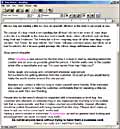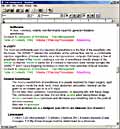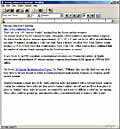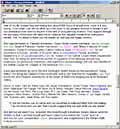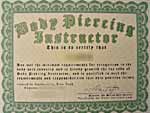
|
Tag Archives: the-publishers-ring
Post navigation
The Arrest of Todd Bertrang [The Publisher’s Ring]

|
The more restrictions and prohibitions in the world, the poorer people get.– Lao Tzu
|
As I write this, Todd Bertrang and his parter Robyn sit in prison for allegedly conspiring to perform female circumcisions on minors. The procedure they were offering is encouraged by the medical community, and, with slight (gender) variation, is even legal for non-doctors to perform. Not only that, but there never actually even were any minors — the whole thing was a cleverly concocted fantasy designed to entrap Bertrang. No matter what your opinion of Todd (he’s never masked his sexual overtones), this arrest is troubling on two levels — first, because it involves a deeply hypocritical law, and second, because it involves a questionable sting on a body modification artist.
To be clear let’s put the procedure in question into context: female circumcision. FGM. Female genital mutilation. It sounds terrible, doesn’t it — but it’s a loaded term chosen by activists (male circumcision is known as MGM, or “male genital mutilation”). The procedure we’re talking about isn’t an infibulation or a clitorectomy — it’s a circumcision (“to cut around”). The purpose of the procedure is to reshape the labia into a more pleasing form and to reduce or split the hood in order to make the clitoris more exposed. The procedure is designed to be a positive and enhancing one, not something oppressive or abusive.

The Hypocrisy
Proponents of female circumcision in the West (it’s a popular elective surgery) will tell you that it enhances the appearance of the genitals, as well as making sex more physically pleasurable. Proponents in Africa and the Middle East will tell you that, on top of its cultural and religious importance, it maintains cleanliness, prevents disease and cancers, keeps a couple together by making the man able to sexually satisfy the woman, and otherwise protects the woman who receives it. Some regions even have circumcision methods designed to make intercourse more physically pleasurable — in countries that it’s done in, it’s the women who have had the procedure that are usually the strongest proponents of continuing the practice.
Now don’t get me wrong — in spite of all these wonderful things about it, I believe it’s fundamentally wrong to force this on a child who can’t decide for themselves, let alone to allow an unqualified practitioner to do it. But we have to take an objective look at this in light of procedures that we do allow.
While most Western countries have phased out the procedure as barbaric, and the AMA has decried it as pointless and dangerous mutilation, in America, the genitals of young boys are still routinely partially amputated. The foreskin, one of the most nerve-heavy parts of the male genitals (and containing glands essential to genital health), is cut off, usually without anesthesia. Significant complications arise annually and numerous men permanently lose sexual function from this procedure. While it is most commonly done by a doctor, non-medical practitioners are also permitted to perform the procedure in private home ceremonies. No health benefits have ever been conclusively shown for this procedure, and the original justification for performing it was to reduce masturbation by “associating pain with the penis”.
So, with boys, we allow non-medical practitioners to cut off part of their genitals for dubious reasons, but with women we don’t. The fact is that we can’t have it both ways. Either make male genital mutilation illegal, or allow it for both genders.
The Sting
Underground cutters tend to be motivated by two factors. First, they usually enjoy doing the procedures they offer. Second, they care about the people they are working on and perceive themselves as helping — by offering a procedure that’s not available in the mainstream, they fulfill an important need and improve someone’s life (and thus they feel a need to come to the aid of someone in distress). The authorities understand that and in their stings play to the desires and ethics of their victim, dangling the perfect carrot in front of their noses.
It’s no secret from his actions in online chat rooms that Todd wants to believe that there are cultures that accept his views on female genital enhancement procedures. Additionally, talking to him it’s clear not only that he’s “getting off” on doing the procedures, but that he cares about his clients. The FBI appears to have presented Todd with a fabricated situation that seemed to good to be true — the opportunity to help a pro-circumcision family (ie. a culture that accepted his belief structure), and to improve two young girls’ lives.
Maybe you’re saying, “Shannon, are you insane? He was a pervert who was hoping to get off cutting up young girl’s genitals!”
That may or may not be true, but the fact is that those girls never actually existed and Todd never sought them out — the FBI presented them to him along with a tailored backstory to make it appear to Todd like he was doing the right thing by allegedly agreeing to perform the operation. Given that it was happening on minors with the full consent of the “parents”, and with the presented goal of helping the minors, can you really say it was even illegal? (Remember, we allow parents to send their children to absolutely brutal, sometimes fatal “Boot Camps”). In Todd’s eyes, and in the eyes of millions of people around the world, this procedure is positive and normal (which would make the government the oppressor, and Todd an agent of freedom). The FBI basically tricked him into allowing his beliefs and ethics to get the better of him.
I’m not trying to defend Todd with this article — if the allegations are true and he offered to work on minors like this, in my opinion he went too far. However, I do feel that it’s fundamentally wrong to charge someone for a crime that only exists as a police fabrication, and I believe it’s even more wrong to charge someone with laws that are by their very nature racist and sexist. These are unjust laws being applied with a heavy hand. Maybe Todd hit on you in a chat room and you’re glad to see him finally go down — but are you really comfortable having it happen like this?
Most body modification happens in a grey area. It’s usually not entirely legal, but it’s also usually not entirely illegal either, depending on how you look at it. Because of this, it’s very easy for almost any body artist to be arrested at any time, based on the whims of local or federal prosecutors. Body modification procedures are safer than everyday activities like driving a car, occur almost exclusively between consenting adults, and usually involve procedures not being medically offered (making underground the only option). To be clear, the laws are fundamentally unjust. Until we either start banning everything, or these procedures start getting medically offered, it is wrong to deny these grass-roots solutions.
The other reason body artists should be wary is if the FBI is setting up stings that seem “too good to be true”, you never know who could be next or how. Most body artists are pretty honest easy-to-read people — it’s very easy to figure out what makes them tick. We’ve accepted as a culture that it is wrong for our authorities to engage in entrapment (entrapment being when the police fabricate an illegal act, encourage the mark to take part in it, and then charge them for it), yet we’ve just watched Todd Bertrang fall victim to it. Because of the seemingly heinous nature of the charges (mutilating the genitals of young girls), most people don’t even consider the fact that this isn’t justice — just like we’re instinctively ready to act outside or beyond the law when it comes to dealing with child molesters and sex criminals.
So objectively, what we have here is an arrest of questionable legality for a fabricated crime, which is only a crime under laws which are hypocritical at best. Ask yourselves — are you willing to allow it to happen just because you don’t like Todd? Then ask yourselves a second question — will it happen again? What do you believe in that the mainstream may not agree with?

Shannon Larratt
BME.com
You can get in touch with Todd via his website at ToddBertrang.com, although you should be aware that all communication is probably being monitored.
Pierced? Get out of America! [The Publisher’s Ring]

Pierced? Get out of America! |
“The more restrictions and prohibitions in the world, the poorer people get.”– Lao Tzu
In her opinion piece “How to win at the game that is America” (LINK), Erin Simovic writes that those with piercings and tattoos are “simply not in their right minds”, make no contributions to society, “look like circus members from the underworld”, and are losers who are not fit to be a part of America. This is far from the first moronic article that Ms. Erin “whatever happened to good old-fashioned courting” Simovic has written, but it shines of hatred trying to hide behind a banal smile, her apparent hallmark as a journalist.
She begins, as Rommel did before her, by insulting her subjects, but somehow trying to justify it with an “honest, I’m cool” footnote, which instead serves simply to illustrate how lacking her understanding is.
“Spiky, multicolored hair, chains, studs, piercings, face paint, you name it. It’s the scarifying of America, powered by celebrities like Marilyn Manson. Okay, I know what you’re thinking — sheltered little suburban girl totally out of touch with reality — but you couldn’t be more wrong. I’m hip. I read the Sears catalog. I’m so totally in touch with the kids of today.”
Leveling out at a simpleton’s “gross, I hate you”, Simovic never manages to do anything but string together a series of shallowly hidden insults —
“...those strange city-dwellers who feel compelled to express themselves with bizarre fashion choices. I am being polite, mind you. I would have used ‘freakish,’ but I figured that wouldn’t be politically correct.”
That’s like me saying, “Erin Simovic has poor comprehension skills that are further masked by her xenophobia. I would have said that Erin Simovic was a stupid hateful bitch and it’s people like her who make ‘white’ an insult, but that would be rude.” The underlying point is clear, is it not? Just because you’re smiling when you insult someone doesn’t mean the insult wasn’t real.
 Erin Simovic, Oregon State’s own Betty Bowers. |
Photo: The Barometer
She goes on to clarify that she doesn’t get it with whiney remarks like “why would anyone in his right mind choose to alienate themselves”, and then punctuates them with further insults. She bitterly writes, “these individuals either want to rebel from society or are simply not in their right minds — I tend to lean toward the latter myself.”
She continues, and after a jab about how no one looking like this would ever be a “Miss America contestant”, demands that people with piercings and tattoos make “real efforts to change what they don’t like about society” instead of making buffoons of themselves by wearing “a studded dog collar”. Perhaps she has never been to a protest, or a meeting of environmental activists, and noted the sheer bulk of piercings and tattoos in attendance? If anything, statistically those with body modifications and “nonconforming fashions” are far more likely to be socially progressive and politically active. After a bit more whining and belittling of others she comes right out and says that she believes that the goal of those with piercings and tattoos is to “destroy society”, an opinion so ludicrously removed from reality that one has to start seriously questioning Ms. Simovic’s lucidity.
She goes on to say that those with piercings, tattoos, and unusual fashions aren’t “playing the game”. As a conclusion, she decides that America isn’t ideal for the modified, and that America “will never be for you” if you have piercings and tattoos — a bold statement, given that many would hold that America embraces freedom of expression, and that the wonderful thing about America is that you can do whatever you want as long as it’s not hurting anyone else. (In theory anyway).
I’m not so deluded that I think people should have to like body modification, or that people should be punished if they make hateful bigoted statements like Ms. Simovic does. But I do think that we need to ask ourselves exactly what’s going on when a newspaper publishes articles which serve one goal alone — the dissemination of hatred. This column isn’t “funny” or “witty”. It isn’t “insightful” or even “social commentary” on any level. It’s just an excuse for Ms. Simovic to broadcast her bigotry, and it’s very sad that Oregon State’s Barometer feels this is how it wants to represent itself and the students of Oregon State. I realize that ultimately it is an “opinion” piece, and she certainly has the right to her opinion, but as a journalist she also has a greater duty to a balanced truth.
Let me make it simple: If you don’t like piercings, don’t get piercings and don’t hang out with pierced people. If you don’t like Muslims (I’ll refrain from theorizing as to Ms. Simovic’s feelings about those of color), don’t adopt Islam as your personal faith and don’t hang out with Muslims. But don’t think that your dislike and personal hatreds, coupled with free speech, makes it somehow “ok” for you to broadcast what a horrible person you are, and try and have others adopt your hatreds as well. It might be legal, but it’s definitely not ethical. America — and the modern world in general — is about a myriad of different people getting along and integrating. It’s not about the destruction of other people’s ideas and the eventual creation of a homogenous culture, and it’s not about one esthetic betting superior to another — it’s about a rainbow of different ideas getting along in a rich human fabric.
It’s very sad that Erin Simovic would choose to supplant that with her own boring, bitter, and repressive worldview, and even sadder that a newspaper would see fit to help her broadcast those attacks.

Shannon Larratt
BME.com
The article in question, “How to win at the game that is America” can be found online at http://barometer.orst.edu/vnews/display.v/ART/2004/01/06/3ffae8b99ea61 and Simovic may be reached by email at [email protected]tudentmedia.orst.edu.
UPDATE:
After seeing the feedback her article generated, Ms. Simovic posted,
After reading all this feedback, I am very sorry for what I wrote, I will look at tattooed and pierced people with more respect from now on and not base their characteristics on what decorations they choose to put on themselves.To be honest, I actually find tattooed guys nicer than non tattooed guys because they are able to express their feelings easier, and also they are better in bed. I would know because I am one of those 'been around the block' chicks
Many readers continued to decry her article, not taking her apology as particularly serious. Katie replied,
You once again generalize by saying that you find tattooed guys to be nicer, able to express their feelings better, and "better in bed." Then you go on to boast about your "promiscuous" lifestyle... maybe you don't approve of my ten piercings, but don't expect me to applaud you for being a whore.
Top Contributors, 2003 [The Publisher’s Ring]

Top Contributors, 2003 |
“A hundred times every day I remind myself that my inner and
outer life depend on the labors of other men, living and dead, and that I
must exert myself in order to give in the same measure as I have received
and am still receiving.”– Albert Einstein
|
One of the many prizes, a limited-edition custom BME belt buckle. |
|
Not that I don’t work damn long hours, but BME is first and formost a
group — community — effort. BME exists because of the drive
of thousands upon thousands of people of all ages and demographics around
the world believing in its value, and wanting to help bring that to
others. Because of that, at the end of every year I like to do this
little awards ceremony to thank those that went out of their way to
“help in bulk”. It is these people who built BME in 2003 (and some in
2002 also).
The competition was a lot harder this year, with BME’s submissions
running at approximately double last year’s speed. Instead of just
doing a top-50 rundown, this year I also split the awards into sections
to recognize the contributions by category. Click any of the pictures
below to check out the winners (and their “acceptance speeches” in some
cases too):
 Experience Authors |
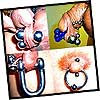
Body Piercing

Tattoos

Ritual and Culture

Scarification

BME/extreme
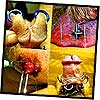
BME/HARD

Top-50, Images

BME Staff
The prizes included custom limited edition belt buckles (which you can see
above if you have Java turned on), and a series of rather odd limited
edition shirts (and more):

What?!? You want to see them in detail?
You’ll have to wait until the winners
send in photos for the t-shirt gallery!
Again, thank you so much to all of you that helped, and especially those of
you who made it to these top-lists. I really couldn’t do it without you, and
I look forward to working with you more in 2004 and onward. The 21st century
belongs to the individual!

Shannon Larratt
BMEzine.com
Straightedge and Modified [The Publisher’s Ring]

Straightedge appears as an interesting connundrum — it advocates a strong sense of community, yet it willfully isolates itself from the mainstream. It advocates clean-living while over-indulging in risky behavior like body modification, glorification of violence, and even body rites. Its adherents aim for serenity while often embracing conflict and choosing fashion statements of guerrilla warfare and gangsterism… Earlier this year BME did a series of interviews on the subject, and, after sitting on my desktop for six months, I’ve finally had a chance to put them together for you here. 
|
Well over a decade ago I spent a year — as an artist — researching LSD use in combination with bloodletting in the development of both an artistic and a spiritual voice. As a result I was offered and accepted a full fine arts scholarship to York University and there was able to pursue modifications more seriously, and I also met my current business partner as well as a friend who’d later help me create BME (as I didn’t own a computer at the time suitable for publishing). My conclusion from all of my experiences is that — when used responsibly — the role of psychotropic and psychedelic drugs is very similar in destination to body-oriented ritual. I also believe from my personal experiences that the psychiatric effects — the “redefinition of self” — that comes with mind-altering drug use echoes the redefinition that comes with body modification.
In addition, my feeling is that even without these similarities, straightedge was incongruous with body modification since it involved injecting foreign substances into the body and certainly fell into the same “risky behavior” category as sex — and one could argue that there were “addiction” issues as well. Body ritual I figured was a definite no-no on account of willfully inducing altered states!
Because of that, it came as a surprise when one of the most visible and vocal body modification groups that developed as tattoos and piercings popularized was the straightedge movement. At this point “drug free” subcultures represent between 10% and 15% of IAM’s membership. Most of the encounters that I recognized as being with straightedge people were militant — typically after they’d gotten in one dispute or another. To cite a recent example, after being asked why he had posted death threats against members of BME involved with drugs*, and how he would feel if the situation were reversed, Danny “I wear the X as a symbol of war” Trudell (of Seventh Dagger) wrote me,
If you want the right to say “look at me I have cut off my genitals and am an utter freak” then you would have to extend the same privelige [sic] to others and their views and lifestyle choices. Grow up and hey while you are at it get the mother of your deformed child not to drink while she is pregnant next time.
Not that it’s a sin unique to edge, but apparently he didn’t understand that there is a difference between loving yourself, and hating others!
* To avoid accusations that I’m misleading you, the issue began with a graphic shirt he was promoting on IAM saying “KILL YOUR LOCAL DRUG DEALER”. Like it or not, IAM, like all large international communities, has many members who are involved in drug trafficking, sometimes legally, sometimes not, depending on the culture they live in. Whether you agree with the act or not, one of IAM’s core philosophies is that you can’t threaten to murder your fellow members!
These sorts of baseless (outside of anything else, my wife doesn’t drink and my daughter is high-functioning and certainly not “deformed”) and bizarre attacks — reflex-like anger responses really — had me believing the stereotype (perhaps falsely) that most people were straightedge because of some sort of internal conflict, self-esteem issues, or childhood trauma that was making them unable to think clearly on the subject. These interactions seemed to typify the relationship that the militants were fostering with mainstream society, needlessly alienating themselves and non-militant straightedge in the process — as they say, the squeaky wheel gets the grease… and a bad apple ruins the lot.
Of course, on the other hand I knew people like Phish of Slave to the Needle in Seattle, or Brian Decker (“xPUREx”) of Sacred Body Arts in Manhattan, both very talented piercers and modification artists — and of course Emrys Yetz, the driving force behind the influential suspension group Rites of Passage, to name just a few of many. All are vehemently straightedge, but sane, lucid, and deeply involved with body modification and mind-altering body ritual. I decided to sit down with them and others to talk about how their straightedge lifestyle fit in with their body modifications. After a little arguing back and forth, we were also joined by Danny Trudell who I quoted earlier.
BME: Tell me a little about what straightedge means to you, and why you chose it for yourself?
PHISH: To me, straightedge is not indulging in mind altering addictive substances that will affect my quality of life — or the lives of those around me. This includes alcohol and all drugs that aren’t prescribed to me for strictly medical use. It also includes tobacco. I saw my own life and the lives of my friends and family being so drastically affected by my early drug use, that I made a pledge to stay away from things that affected me in that way.
EMRYS: Straightedge is a drug free lifestyle. Some say you can’t drink caffeine, some say no sex before marriage, and some people go as far as saying you need to be vegan as well. In my eyes as long as you’re free of drugs and alcohol you can call yourself straightedge. I usually just say I’m “drug free” — not “straightedge” — to avoid the stereotypes.
BRIAN: I also usuaully use “drug free” or “poison free” over straightedge to describe myself nowadays. A stigma has been attached to that term that exudes such a negative characterization. I am not this person — don’t let the militant groups give me a bad name, cuz I’m not a bad guy!
Anyway, it’s a drug-free path which allows me to deal with life — its problems and its fun — with clear judgement 100% of the time. I chose it because if I can’t see something for what it really is, without distortion, I don’t need to see it at all. I know myself to be a fun and outgoing person without ever needing the “help” that some people have told me they need to find this person inside themselves. I like to think I’m a stronger person because of it.
JASON: For me it’s trying your hardest to live a low-risk lifestyle and keep your body clean, natural, and healthy. By low risk I mean sickness and disease — no promiscuous sex! I also feel that veganism is a natural extension of sXe since meat is merely an intermediary between you and chemicals, at least as far as agri-business is concerned.
I decided to stop drinking after a really drunk night in college — when I figured it would be a good idea to attend the riot I heard about on the news. At the end of it I’d been shot by the police and beaten extensively with batons! Alcoholism runs in my family, as does being a violent drunk, so I figured it would be for the best if I stopped drinking then. At about the same time I met other like-minded people at college and discovered the straightedge community. Before long it was just second nature not to drink, and just chill with friends.
Being straightedge has cleared my mind and body and made me a much more conscientious person. I feel more in touch with my environment and my friends. It’s given me hope and strength where religion has failed me, and it’s taught me to believe in myself. I used Catholicism as a crutch in hard times in the past, but this is not the same escapism.
EMRYS: I was at a very low part of my life — I was motherless, fatherless, and left to raise myself. I was in a haze of drugs, trying to run from my problems, and was about to end up dead like my parents, or in jail. I decided that if I was going to prosper in life I’d have to sober up. I didn’t want to work a dead end job just to make enough money for my next fix, even if it was just cigarettes. I lost a lot of friends when I made that choice, but I feel more alive than ever. I have more energy, I’m able to remember things, and I achieve my goals — I think if I hadn’t become straightedge I’d have slipped deeper into drugged states. Being edge gave me something to work towards, something that no one could take from me, that I could be proud of — I overcame my addictions, and I face my problems sober.
JASON: Straighedge has its downsides as well — I grew up in Dayton (home of the “Courage Crew”, an aggressive straightedge gang) and have gotten a lot of negativity from people who found out I was edge. I’ve even been sucker punched for it — “Do you want a beer?” “No thanks, I’m edge” — WHAM! and I’m on the floor. Through IAM I met a lot of really cool edge people that weren’t militant and just wanted to have fun — then I started calling myself edge again. I’m vocal about it now because I want to show people that there are straightedge people out there who aren’t assholes — straightedge should be something good, not something condescending.
BRUCE: I don’t identify as straightedge — I just haven’t done drugs or alcohol for the last six years in order to save my life. I grew up in the DC hardcore scene in the early 1980s where Ian MacKaye of Minor Threat coined the phrase in the first place, so I’ve probably been around straightedge for over twenty years now — back then it was just a way to alienate yourself from the norm. The community was very tight-knit and cliquish, and very anti-woman.
Now there seems to be an underbelly of violence and preachyness — today’s mosh pits with the thrown punches and karate kicks which purposely do harm to others… When it was just dancing and thrashing sometimes people did get hurt but when someone went down others picked them up — the last pit I was at when someone went down they got kicked in the ribs. You see it in the violent symbols they choose — bats, brass knuckles, knives, and so on. Those were not part of the old movement of politically conscious human rights oriented goals!
It doesn't take a big man to knock somebody down
Just a little courage to lift him off the ground- DROPKICK MURPHYS, Fightstarter Karaoke
BME: And what drew you to body modification?
PHISH: My first lobe piercing was in 1979 when I was eleven. I watched a lot of pirate movies and always liked them. When I was fourteen or fifteen I was at a party and saw a tattoo that a friend of my older sister’s had — I can remember the design as if it was yesterday — and started becoming really interested in tattoos.
BRIAN: When I was about ten years old I was going to all the kickass 80s metal shows. You know, Motley Crüe, Skid Row, Van Halen, Metallica, and all that. The older (and so much cooler) people at the shows proudly exhibited their piercings and tattoos. I looked up to them a lot. When I got a little older, the metal turned into punk and hardcore. All the piercings and tattoos were still there — even more so. So, I guess the music I listened to and the people I revered in the bands and in the crowds drew me towards modifying myself for status.
Now, I am modified for the sole purpose of showing off who I am to myself, to my friends, to my family, and to strangers. My drug free tattoos are there to tell myself and remind others how strong I am for what I can do, and the things I’ve achieved. I hear far too often, “You do what with hooks where? You know you have to be fucked up for that. What kind of drugs are you on?” My proud response… none. Suspending is another way I prove to myself how much I can accomplish with my mind.
EMRYS: When I was nine years old I carved “EY” into my forearms with my first pocket knife. When it healed I did it again and again until it stayed. It hurt more to cut it deep so it would stay, but the pain of cutting it was made worth it by the pleasure of having the marks. After I did it I felt energized.
Growing up, my mother hung out with a lot of bikers so I was always around pierced and tattooed individuals. The piercings I wanted most were my nipples because I thought guys had no reason for having nipples — if I decorated them with jewelry, they would serve a purpose. So, when I was thirteen years old I got my nipples pierced, and the woman who did them later apprenticed me!
BRUCE: When I took the drugs and alcohol out of my life, there was a huge void. I didn’t know what to do with myself! I became aware of things in the world I hadn’t really thought about. For some reason piercings and tattoos stood out as a way to separate me from the norm… Within six months I had my lobes pierced and three tattoos and started feeling better about myself. My self-esteem started to rise, and the natural endorphin rush of getting tattooed was a thrill I enjoyed when I thought I’d given up all the things that got me off — yes, it got me off.
JASON: My first piercings were done with a gun the day before I left for college — my girlfriend and another close friend all did it to show we’re together, no matter where we were. I met a few kids at college who were more into mods and discovered BME (this was late 1996). I became immediately fascinated. Like a lot of modded people, I’d read National Geographic all my life, but not until BME did I realize how normal this was — I was addicted and spent hours pouring over the texts and pictures. Slowly the “I would never do that” turned into the “I’m not sure I’m ready for that… yet!”
I got my tragus pierced first, and not long after, another cartilage piercing, and after some encouragement from my friend Ian I plunged into genital piercing, getting a few scrotal piercings, a lorum, an a frenum. Then came July 1, 2001 and iWasCured.
I drove six and a half hours after being told I could do a flesh pull — it seemed like the logical extension after being relatively pierced and tattooed. The drive was horrible, and I was manic the entire time — I kept bouncing between thinking about how amazing this was going to be, and flipping out about what the hell was wrong with me for wanting to so something like this.
But it turned out great.
After a few more visits with iWasCured, Phil [Barbosa] asked me why I didn’t start doing suspensions back in Ohio. I told him I wouldn’t know how, and immediately the crash course in suspension started. Not long after, iHung was born.
Suspension has become my obsession in life. Everything that I see that is taller than me, I quickly analyze it to see if I could feasibly hang from it. Suspending puts me into my mind’s space like nothing else has ever done. I have clarity, and it shows me what my life really means — enjoyment, good friends, and family. After my first suspension in your back yard, I was addicted… I knew it… I was able to think about my life and see myself from an outside perspective — I was able to just witness myself being myself and not trying to be anything else.
Suspending and piercing have helped me get through a lot of rough times. In the past I used the pain of getting pierced to remind me that I was in control of my life, and those moments helped me get my life back in order. These days suspending is even more important in my life because I travel and am able to give others the opportunity to suspend — I see people’s eyes as I hold thier hands when their feet leave the ground. That brief shimmer of reality that overwhelms every sitcom that they have ever been brainwashed by. The tears of pain and joy that people shed, I shed as well… When I assist someone with a suspension, a small part of me is hanging with them. I feel it.
Being raised Catholic I was used to ritualism — when I stopped believing in Christ I began to miss the ritualism of Mass. I think suspensions helped fill that gap. On the same thought, drugs have similar rituals with them — packing the pipe, lighting it for someone else, passing it around the circle. I can definitely see the correlations between drugs and rituals of the flesh… They are different doors to the same room.
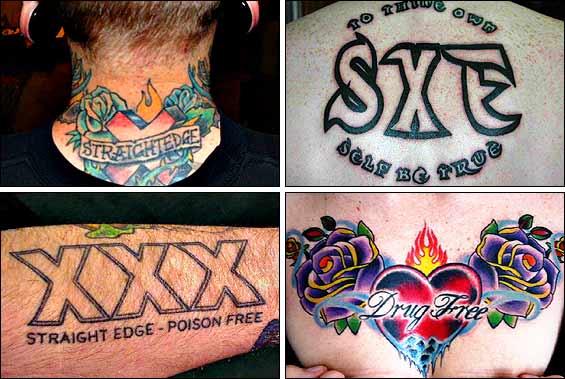
BME: I guess what I don’t understand is that if promiscuous sex, putting drugs into the body, and so on are “bad”, then why isn’t “damaging the body” and inducing drug-like states from endorphins (ie. body modification) a bad thing as well?
BRUCE: Hey, I love promiscuous sex! But I can’t argue this point — I’m fucking high as a kite when I do a hard pull. There’s a great picture of me at LexTalonis’s second social with my cheeks skewered. I look stoned out of my mind and pretty much was.
JASON: My friends who do drugs have the same conversations with me about their experiences with psychedelics as I do with them about suspension. We each found a path that works for us and there are parallels between these paths. The difference is that with drugs there is an outside chemical being introduced into the body to achieve altered states, whereas with ritual like pulling and suspending, these use the body to achieve those states.
As it relates to straightedge, it is possible to get addicted to the adrenaline or endorphin rush — that’s where the old adage “all things in moderation” comes into play… or is that a cop out? Addiction is addiction no matter what the substance is. So maybe it’s “not straightedge”… But I don’t feel that it makes me any less edge since you can achieve similar feelings through hard workouts, skateboarding, or other rigorous exertion.
Suspensions are like exercise to me — I get a nice workout from it and I feel better afterwards.
PHISH: I don’t believe modifications control our lives like drugs and alcohol do — mods affect us in a positive way. They become part of us — I’m not talking about the spiritual sense, I’m talking about the rather obvious physical way. They raise self-esteem and confidence in ways that drugs can only do for short periods (which are just illusions anyway — and often end in the opposite emotion).
EMRYS: Modifying the body isn’t contrary because you’re changing your body in a way that will eventually heal and sometimes better your body and raise your self-esteem. Drug use on the other hand breaks down the body and causes irreversible damage such as destruction of brain cells, liver cells, and so on — modification practiced responsibly won’t cause any problems like this.
As far as body rites giving a drug-like state, that is your body’s natural reaction to what you are putting yourself through — not something you are taking. It’s produced inside the body. That said, if you’re doing the body rite purely “for the high” then that’s probably not very edge.
BME: I see a lot of young straightedge youth getting new mods constantly — is there a worry that maybe one addiction is being traded for another?
PHISH: I’ve never really subscribed to the “mods are addictive” philosophy. Addiction is a compulsive need and is characterized by things like withdrawal pains — and I’ve never seen anyone have even psychological withdrawal from lack of mods! Anyway, lots of groups patronize our business, not just sXe’rs.
EMRYS: …And not everyone who does drugs is addicted to them. If this is an addiction (and I don’t think it is), this is an addiction that betters me, not one that destroys me.
DANNY: Straightedge, simply put, is abstaining from drugs and alcohol. End of story. Getting too many tattoos is not hazardous to my heath, nor do they adversely affect my ability to function.
BME: Well, it does make it hard to integrate into mainstream society…
DANNY: If I wanted to do that I would drink and watch the Cubs game. I am not interested in mixing in with this society — clean living does not mean “fitting in with society”. I am straightedge, not a member of the Boy Scouts or Young Republicans. Straightedge has nothing to do with fitting in or mixing well with society. If anything, it is totally against fitting in becasue the norm is using drugs, drinking, or smoking, and sXe as a philosophy says, “stop and think about what you are doing, and the consequences it may have — don’t mindlessly consume”.
Society teaches from day one that these destructive behaviours are acceptable, just like they teach you to go to church, get married and have two point five children, animals are for food, or any number of other social “norms” beaten into you from birth. Everywhere you turn society is pushing drugs, but despite society’s desire for me to be unhealthy and appathetic I refuse to join in.
But to return to your original question, anything can be addictive. It is not the purpose of this movement to contol all addictive tendencies — though I would say that the discipline I have learned through sXe has tought me to moderate everything in my life.
BRUCE: With my own mods I have really had to contemplate the consequences before I go through with them. There are mods I like a lot that I won’t get because I would be crossing lines into addiction. So I don’t.
JASON: Straightedge isn’t really about “life without addiction”, it’s about being substance-free… Most sXe kids aren’t willing to talk about this — often times, at least in Dayton, kids claim edge because they don’t know anything else. They go to shows and see the tough guys who dominate the dance floor and want to be them. It’s sort of an upper crust that people flock to without giving it much critical thought. This leads to a lot of “sell outs” since they didn’t really know what they were getting into.
People rarely admit that there are flaws in their decisions, and the addiction trade-off is no different. I know several edge people who drink Mountain Dew (heavily caffeinated) like it is their job — to me that’s pretty un-edge. But edge is a personal decision and not some hard-line rules.
BME: Have your modifications played a spiritual role?
PHISH: My spirituality is from my sense of self; I don’t get it from mods or ritual play.
BRUCE: I think I have become more spiritually in-tune with my body. I just know it better.
EMRYS: By concentrating on my body and modifying it the way I have, it keeps my mind and body working together — it reconnects them when they start to fade apart. I feel in control and more aware of my body as I change it to how I want it to be. When my body is in pain when I’m doing a body rite, my mind has to take care of my body, and my body and mind talk to each other to handle what’s going on — I am aware of both of their messages because they’re working together on a level that they normally don’t achieve.
JASON: Spiritually, modification and body play has given me faith in myself again. After I gave up on organized religion I was deeply depressed — probably because I didn’t have anything to believe in and didn’t have faith in myself. Catholicism had let me down when I realized what it had done to other cultures, and straightedge had let me down due to ignorant assholes stigmatizing it. I’d let myself down and was failing school, and I felt like I was letting down my friends and family as well.
Body modification pulled me out of that shell and when I was emotionally level I did my first pulling. That opened my eyes to the natural energies of people — never before had I felt so at peace and completely moved at the same time. At that moment I realized that there is far more to the world than what I had ever been taught or really told about.
BRUCE: Twenty years ago I took a 30-day mountaineering course — complete outback, backpacking, with no contact with the outside in the Cascade mountain range. Two weeks into the course while crossing a boulder field I fell — my sternum hit a boulder and I was driven into the ground with an eighty pound pack on my back. I was hurt (but not as bad as I made it seem) and had to stay out for two days while the course went on — I gave up. I felt weak and like shit. My younger brother was a professional climber in the Himalayas and I had failed a backpacking course because I couldn’t handle the discomfort.
This tormented me for years, knowing I was weak and weak willed, knowing that I failed, and feeling like the only one who had failed. This hurt and I got therapy, but nothing helped. My self-esteem was obliterated.
That moment I said “take me up”, with the hooks in my back and my feet off the ground, and I swung back and forth, all thoughts of personal weakness were gone — my self-esteem has risen ten-fold since then. I feel worthwhile. I’m not a failure. I kicked motherfucking ass! I’m so glad my life doesn’t revolve around mind-altering substances — I’m so fucking happy I can’t stand it! If that’s not spiritual re-birth, I don’t know what is.
BRIAN: When I ready myself for a modification or suspension, I promise myself I will not back down until I get what I want or need from the experience. I get panic attacks pretty regularly and if I can prove to myself that I can overcome the pain, anxiety, and suffocation that comes from hanging from a single hook over my sternum, then I should be able to deal with a racing heartbeat and unexplainable fears that I know will be gone in five minutes so I can make it to work on the subway in the morning.
BME: And how has being straightedge changed the way that you perceive mind altering ritual play?
BRUCE: Without giving up the drugs and alcohol I would never have known or been aware enough to be involved in these things. Giving up the drugs and alcohol actually opened up something in my life that I now know I could not live without. I went from a used up worthless human being to someone who cares, is strong, and open to a daily world filled with life. I can’t even imagine how I lived with the blinders on for so many years.
JASON: It definitely helped me. I can’t imagine suspending while under the influence of any substances. To me it would dilute the effects of the suspensions and make it more difficult to obtain the clarity that I have during rituals. Then again, it could add a whole other level to it!
PHISH: Straightedge does help me because I can experience all of life in a coherent state of mind. I like to remember all of my experiences. If there is going to be a “spiritual” experience, I’d prefer having it from the experience itself, not from chemicals.
EMRYS: Yes — it’s simple — being sXe meant my mind was clear and my body was clear. I was more able to comprehend and understand what was taking place and happening to me.
BME: Given that rituals traditionally used to seek enlightenment involved drug-assisted altered states, or even non-drug altered states, is there a worry that there could be a conflict if you pursued such a path?
DANNY: I don’t have a lot of experience with this so excuse my ignorance. However, I am an avid runner. I run every day so the closest I can come to understanding what you are talking about is what they call “runner’s high”, when your endorphins kick in from the physical stress of running, making your aches and pains less painful, and making you feel like you can run more. I don’t see this as dangerous — that is not ingesting a mind altering substance, and it’s not engaing in an addictive or destructive passtime.
JASON: For me, being straightedge helps keep me on that path, and I know I’m not being influenced by the substances. If I was asked to take part in a ritual that involved taking drugs, I would politely decline but take in as much of it as possible through observation — I’ve done this with friends on hallucinogens. If I was traveling and had the opportunity to take part in an indigenous ritual that involved some drug use, I’m not certain what I’d do — declining such a once in a life time opportunity would be tough.
EMRYS: As someone who is planning his own version of the Sundance, I’ve had to face whether I want to include tobacco and other mind altering substances to follow the tradition of the ritual. After long thought and a lot of discussions I’ve come to the conclusion that technically it is “breaking edge”, but because it’s in a controlled manner where you’re using the substances for their intended purpose, I don’t think it would be a violation of my beliefs. I have chosen that when the time comes I will stay true to the ritual.
BRIAN: I admit, I take a prescription med every morning, to help keep my heart beating at a “normal” rate, and my tension down — I could easily take the easy way out and drink and use heavier drugs to deal with my problems with anxiety. I know a lot of people who do. I definitely think I’m a much stronger person for doing it “on my own”.
BRUCE: My past altered states achieved through LSD, mescaline, scopolamine, and so on were, to me, false altered states — just dreams. Taking those things out of my system has allowed me to go inside, to discover myself, who I am; not a lie. I do achieve some altered perceptions through body rites, but I view them as clean and pure, because they are totally me. I could never achieve them through drugs.
PHISH: Personally, I’ve participated in a lot of mod-related rituals and have yet to have a truly “altered” state of being. I have had an inflated sense of happiness, well being, and accomplishment… but I don’t view those as altered states of being. I’m not saying these rituals hold no spiritual value, but I believe that many people exaggerate these experiences to fit what they’re seeking.
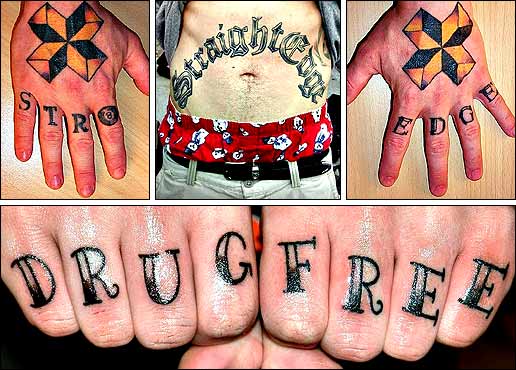
BME: What made you decide to commemorate your straightedge lifestyle with a publicly visible tattoo?
EMRYS: For me there were two reasons — like I said, I used to be big into drugs and knew I had to get myself out. But I’m only human and have desires, so I got my “xDRUGxFREEx” tattoo in small sittings even though it could have been done in one. Every time I got the urge to use drugs or drink I would get the tattoo artist to cancel an appointment. Through the pain it would help remind me of my commitment I made to myself, and also remind me of the pain drugs brought me.
Second, whenever people at the shops I worked at asked me for an idea for a tattoo, I told them, “pick something that you are proud of or want someone to know about you just by looking at you” — I’m very proud of overcoming drug and alcohol addiction on my own.
PHISH: I wear my heart on my sleeve not so much for other people but to remind myself of my strength and pride in myself — there is pride in being able to resist the temptation of substances. I’ve never cared if someone else wanted to drink or drug so I don’t really care if someone else notices my tattoos or not. Most of them are hidden — the XXX under my chin, a sober heart on my chest, and sXe bombs on my thumbs. The tattoos are there for me, not for someone else.
DANNY: The tattoos are an extension of who I am and what is a huge part of my life. I’ve poured tons of time and energy into promoting this lifestyle, so naturally I will tattoo my convictions on myself. It’s no different than tattoos involving my decision to live vegan, or my faith in God. Tattoos being a permanent mark on my body blend idealistically with my permanent decision to abstain from what I believe to be a dangerous way of living.
I’ve always loved tattoos, so it’s natural that I blend the things I permanently believe in with that love.
BME: Do you think that’s why most people get the straightedge tattoos?
EMRYS: It comes down to the pride of being straightedge. Most people choose that label for a reason, for themselves, so they want people to know. I think also for a lot of people once you get it tattooed there’s no turning back — it shows another level of dedication that some people aren’t willing to take.
So many people say “I used to be straightedge”, but if you aren’t now you never were, because it’s a lifetime lifestyle and dedication. The people getting tattooed are showing they’re not “true till 21”, they’re “true till death” — and if they’re not, they are left with that tattoo, or the one that covers it, as a constant reminder that they sold out.
PHISH: I think the abundance of tattoos comes more from the scene (EC hardcore) that gave birth to straightedge, rather than the lifestyle itself. But a lot of straightedge kids of very proud of their achievements and it’s logical to fly a flag of pride.
JASON: Many edge people get their tattoos out of competition and peer pressure I think — that’s why they get them in such visible places. It gets them respect in the community, but it also makes them visible targets if they lose edge. I find it sad that so many people who are edge are pushed to get visible work — I know a lot of people that have deep regrets about their knuckles, chests, throats, and hands. It’s also the more militant members that seem to get these, as if to say, “yeah, I’m edge — you got a problem with that?”
If you look at the general trend of edge tattoos, they tend to be aggressive — it’s about creating a “tough” image. I think that some people get edge tattoos to affirm their belief with others, and so they don’t have to be critical of themselves — if they’re not confident of their edge, but have the tattoos to “prove it”, then their peers will keep them in line, if that makes sense… Like the man who gets married to prove that he’s in love instead of getting married because he knows he’s in love.
DANNY: I will say upfront that a lot of kids get crazy straightedge tattoos way too early in an effort to appear cool or tough.
JASON: It’s been my experience that people with the less aggressive straightedge tattoos — simple X’s or “pure” and other variations — are more passionate about their lifestyle and less passionate about “the scene”. They tend to be the clear thinkers, strong in their personal convictions without preaching to others.
BME: Why do you think so many get the tattoos on their throats?
DANNY: How does anyone end up with a throat tattoo? I started with my legs and arms and before you know it, I’ve got tattoos on my hands and throat. I don’t think it’s inherently sXe to get these things. Whether I’d been involved in sXe or not I would have tattoos in these places — I’ve loved tattoos since I was a small child.
BME: Any last words?
JASON: When I am in need of strength I think about all I have done with my body — what I have endured and what I have felt from other people. It makes me realize that whatever is bothering me is probably rather petty in the grand scheme of things. Through body ritual, my eyes, heart, and mind have all been opened up to a greater presence in life and an awareness of those lives. Being edge gave me the clarity to understand what I saw.
EMRYS: Question: “Why do straightedge kids that break edge go emo?”
Answer: “Because it’s easy to cover X’s with stars.”
I’ve avoided turning this into a debate because my goal hasn’t been to suggest that straightedge is for everyone, or that drugs universally enhance ritual. I think though that one overwhelming suggestion comes forward no matter who you talk to: be yourself, tackle life with a clear head, and enjoy and learn from what it gives you.
Straightedge, especially when combined with the tools that modification and body rites have to offer, can be an effective way of helping achieve that — as long as it doesn’t degrade into joyless and narrow-minded oppressive militancy. I think the reason that path so obviously fails is that you can’t define yourself by what you’re not — that is, saying “I don’t do drugs” isn’t who you are. It’s who you are not. The individuals I spoke to above used their straightedge lifestyle to give them clarity which allowed them to find purpose — rather than attempting to have straightedge be their purpose in and of itself.
Body modification fits well with that, because it’s also a tool with a great deal of application in self-discovery and self-improvement. But ultimately, one must always remember that all of these things — even drugs — when used correctly do not add anything. They simply help you to bring out the best in yourself.

Shannon Larratt
BMEzine.com
PS. All stories have another side — if you have experiences combining drugs with body rites to achieve spiritual enlightenment, please contact me so I can interview you for that side of things!
While most of the feedback I’ve received on this column has been overwhelmingly positive, it has generated some anger as well, mostly due to the sidebar. The sidebar information is collected from news articles and web sites discussing the subject — people are certainly welcome to dispute them, but please understand that I’m simply repeating what’s already considered fact by the majority of the sources I could find, and not inserting my own opinions or notions. My goal was simply to frame the article with some information that would put it into context for people not experienced with the subject.
|
Anyway, on with the feedback:
From: Sean Rivers
Subject: response to articleSerisously what in the hell moved you to write that rediculous article. Ive been sxe for almost six years now, and im also courage crew. I can tell that everything you have said in that article is hear say, cause if you honestly new any one in courage crew, you wouldnt have labeled us that way. Like my good friend Kramer said, most of us all have lives and are all grown up. Me myself have a wife and kid and I work my ass off to provide for them. It serisously disturbs me when I see shit like this, how people just out of no where like to bring up lame ass shit like this. You must have no kind of life to actually spend six months to produce that garbage, journalism was obviously not your major. Im a member of the United States Navy, and it really gets me to know that I might have to actually die defending a piece of trash such as yourself. My advice to you would be retract that article, write and apology and get a fucking life. Grow up and stop causing unnecessary shit. But im fine, cause i know just how many people you pissed off, and i have a smile on my face knowing that you'll be looking behind your back for a lonnnnnnnng time. Just remember this, someone knows someone, who just might possibly know you.
ITSN Rivers, United States Navy USS Ford FFG 54
# # #
From: jill encarnado
Subject: you are full of crap!you are full of shit..you and your article. What do you want to prove?..what's with the edge anyway? is it a crime not to intoxicate yourself? or to fuck or to become a vegan? is it affecting your life?! This morons or idiots who claim to be a straight edge is an impostor! i think no real edge would exagerate himself just to get attention..you're doing this for yourself...stop your crap and get on with your life!!!!
# # #
From: "Ozzy Edge"
Subject: your article fabricates the truth a bit too much!!You should be ashamed of yourself for putting such horse shit in you article. I guess it's not your fault because it's evident you're an idiot already, but prejudging, and generalizing sxe as a movement. First off Straight Edge is inside of me, i'm not apart of some sxe movement. There are a lot of sxe kids that I very much dislike. There's no leader, there never was. Again, every arguement made is not legitimate. Anyone can write an article that is truly opinion, and you have down so, with the most ignorant of opinions. I don't know why i'm even bothering with idiots like you because usually I don't care what worthless people would classify me as.
Another fase analysis, the part about why people go straight edge. You're right by accident in one part saying that many fall into because it may seem like a trend to them. However, if we look at that at a national level that's absurd. I was maybe the 2nd person to claim edge in my city, and I know I had to deal with a lot of ignorant people like you saying stuff to me, and maybe that's why now when people are like "ohhhhhh sxe, I heard they're racist, and homophobic""""""""""""';and on 20/20 they said they're idiots" I don't blame them, because idiiots like you mold their perception on straight edge. FUCK YOU. I am not racist, I'm a turkish Canadian and have definetly fought racism with my own hands. I am not Homophobic you asshole, the word fag may slip from my mouth but i have many friends who are gay and i'm all for it..
The whole violence thing: Another false claim. Hate edge. hahah. that's great you almost make people believe that straight edge kids are hateful because of straight edge and not who they were before. You idiot! There are good cops, bad cops. Probobly because maybe 1% is like this, really violent, and aggressive I've never herad of kids waiting after bars to beat up drunk people. That's the biggest fabrication of the truth, ever! Sure some straight edge kids may fight, I will fight to defend my friends, and family. Also, if you ever have been in a part of town that is known for "clubbing" or people getting drunk. You should also take note, you got a pen and pencil chump??? Alright, you should know that drunk people start fights, and maybe sxe kids more often than other kids won't back down. Maybe they're sick of everyone starting fights. Me and my friends never start fights, and half of my friends aren't straight edge. However, people have started with us and we've all fought TOGETHER to ensure the safety of each other. So what if we look out for each other it doesn't mean much... ANd idiot, if you say we're neo-nazia's again, i willl practise this Militant sxe style and say that I spit in your face and punched you because you're not edge. But Reallly it will be the same reason why anyone gets beats up, because they're idiots.
I Hope you make a follow up article, and that's the only way i'll let this shit slide. I can even help you out on that big guy. If not FUCK YOU, you're just as ignorant and as much of an idiot as 70% of the people out there.
love,
XOzzy ErenX The turkish Neo-Nazi ( that makes a lot of sense, just like your article) and don't forget that i was being sarcastic, it seems you wouldn't catch that because of your stupidity.
XXX# # #
From: joshua kramer
Subject: straightedgeI would like to state that your article on straightedge left me deeply offended. I myself am Courage Crew and are in no way militant. I grew up in a household surrounded with smoke and alcohol and decided that i didn't want my life to be like that, for me to be militant i would have to turn my back on my family and some friends. I have been straightedge for 10 years and i couldnt imagine my life any other way.I don't know who you have met that is courage crew or what you have seen but i believe you are deeply mistaken. It seems nowadays when anything involving straightedge and violence it is always blamed on us. Granted there are instances when individuals that belong to this crew have resorted to violence to solve a problem but that is not always the case and has not been for years. For your information we all have similar beliefs and morals in the courage crew. Everyone that is part of this is either in college , over seas fighting, running their own business , or has a trade of some sort, we all follow a lifestyle dedicated to being physically fit, living drug free, training in some sort of self defense and a strong sense of self sufficiency and self worth. Several of the members of of this crew are grown men with families and are in their thirties... an age where violence has a much deeper penalty and could result in the loss of their families and/ or their businesses. I dont understand how any act of violence is concidered militant.If I was in a situation where i was threatened no matter if they are black, white, sober, or drunk i will not hesitate to defend myself as i assume many people straightedge or not would do. The reference to being neo nazis with hammerskin tattoos was absurd, our crew has people of all races and so does straightedge in general, the hammers are from the Judge album and have been adopted to be used as X's since then. I know members of your site that are cxc and are tattoo artists or body piercers that also find this article offending. I don't quite know what your point to writing this was, it seems to me like you wanted to exploit our lifestyle and misrepresent us in a fashion that makes us look like weak barbarians or hypocrites. As far as i can see you know nothing more about straightedge than you did before you wrote your article. This is a belief that thousands hold dear and it should not be made a mockery. "true till twenty one" I have no clue where this "form" of straightedge was concocted but as far as anyone that is straightedge is concerned if you are not now you never were. I have a feeling that you will just take this letter and exploit it on your website somehow and that is fine with me because hopefully the next person who reads this is a bit more opened minded and realizes that there is another way.
sincerely, Josh Kramer
William Rafti: Piercing Visionary or Scumbag Con-Artist? [The Publisher’s Ring]
 William Rafti: Piercing Visionary or Scumbag Con-Artist?
Those of you in the APP know about William Rafti because of his constant baseless attacks on APP members, his cold-calling harassment of those associated with the APP, and his relentless attacks on respected members of the piercing community such as Sky Renfro. Others may have seen his “ebook”, “The Body Piercing Encyclopedia” — which he for a time marketed as the “replacement” for the APP manual — in various online catalogs, through which he portrays himself as one of the leading minds in modern body piercing.
The truth is, William Rafti is at best an unstable asshole with a wavering grip on reality, if you’re to believe the vast majority of the piercing industry. While he’s willing to go on at length about how he’s the most important thing to happen to piercing, even using the references he provided me with, I couldn’t find a single person willing to say nice things about him or even qualify him as an expert. But still, I decided to give him a chance and asked for a copy of his ebook for review — after all, very occasionally an insane asshole does produce something of value. What I received was emphatically not something of value. In the mail I received a palm-sized plastic bag with a small unlabelled CD-R, which was wrapped in a low-quality print out informing me that I’d need Microsoft Word to view it. When I inserted the CD there was no installation process or welcome message — upon opening it I discovered that to access the documents, I’d have to copy the contents into “C:\Volume” and load the bits of the book into Word from there. When I finally got the book loaded, I found a chaotic mess of documents with constantly changing font sizes and colors, strange hyperlinks (sometimes to various Internet sites), and broken layout. It was riddled with spelling errors and grammatical confusion, and there was an abundance of unrelated files — everything from outdated shareware applications to “jokes” to chat logs of Rafti slandering various well known body modification figures. I was rather shocked at the un-professionalism of it, but still, I tried to give it the benefit of the doubt.
The feeling that you get when reading the “book” is that Rafti just downloaded every bit of body piercing related information online, and then tried to patch it together into a single project under his own name. Not only do the fonts change from “pasting to pasting”, but the style of writing changes as well, implying strongly that large portions of this book are plagiarized. In addition, I noticed that in some sections he would flip between referring to tools by their name (ie. 8mm Dermal Punch) and some sort of product code (ie. #DERM-8MM). I can think of no explanation for this other than cutting and pasting from a manufacturer’s catalog and attempting to disguise it as his own work. And then I read something familiar. William Rafti was stealing material from the old BME glossary, making minor changes to it, erasing my name, and inserting his own as the author instead! I don’t generally mind when people use BME as a basis for their own research — that’s what it’s there for. But what I do mind is when people actually claim that they wrote it. If you want to use someone else’s material, cite it properly! It’s one thing when someone plagiarizes on a school project… but for Rafti to steal BME’s material and try and criminally sell it under his own name takes some real gall. In the tables below, entries from the outdated BME glossary (Rafti did not have access to the new files in the still fledgling BME encyclopedia project at the time) are shown on the left. Entries taken from Rafti’s ebook are shown on the right — please note that in both cases I’ve not always included the entire entry for the purposes of clarity. I have highlighted direct plagiarism in yellow, and I have highlighted indirect plagiarism (where synonyms and alternate phrases have been inserted) with pink. These are only a small number of the examples that I found — my analysis suggests that the bulk of the ebook is plagiarized from various sources (not just BME). I even found some examples where he copied my typos!
|
| Blowout |
|
|
| Blowout |
|
|
| Flexible Bar Piercing |
|
|
| Flexible Bar |
|
|
| Emla Cream |
|
|
| Emla Cream |
|
|
| Epinephrine |
|
|
| Epinephrine |
|
|
| Xylocaine |
|
|
| Xylocaine |
|
|
“Lidocaine toxicity is something that can occur with way too many injections of Lidocaine. A common procedure requiring vast amounts of Lidocaine is Tumescent and Super-Wet Technique Liposuction.”
Sound familiar? It really gets me wondering whether Rafti wrote any of the text in this ebook.
| Marcaine |
|
|
| Marcaine |
|
|
| Soap |
|
|
| Hand Soap |
|
|
| Salt Soaks |
|
|
| Salt Water |
|
|
| Cyanoacrylate |
|
|
| Cyanoacrylate |
|
|
| Gauge |
|
|
| Gauge |
|
|
| Skin |
|
|
| Washing Hands |
|
|
| Nitrile |
|
|
| Nitrile, and Glove, Acceptable Quality Level |
|
|
Again, this is only a fraction of the plagiarism I discovered from BME and other sources in Rafti’s ebook. The rest are reserved for the lawyers should it come to that.
OK… So do I sue this thief into the stone age? I’m a pretty laid back guy, so I decided to do an interview with him about his book and see what he had to say — I was placing bets with myself on whether Rafti would come clean, “be a man”, and apologize, or whether he’d try and keep the lie going as long as possible.
BME: Large parts of the document are directly based on and plagiarized from my own site and from other sites. Why have you stolen other people’s work and presented it uncited and as your own? Did you really believe no one would notice?
RAFTI: “All mankind is of one author, and is one volume” – John Donne
BME: No, I’m serious. Why did you steal my articles and say you wrote them?
RAFTI: As far as anything that I am aware of that I used from others I had permission.
BME: No, you did not have permission. Why did you steal my articles?
RAFTI: With over six billion people in the world thinking millions of thoughts each there is probably no thought that you can think that hasn’t been thought before by someone else. If you mean to imply my thoughts and words are not my own then we are all guilty by circumstance of the same thing.
BME: Look, you copied word for word. Don’t try and pretend it was just a coincidence. Did you really think I wouldn’t notice?
RAFTI: No one else had a problem like this.
BME: They probably don’t know you stole their material. Maybe I should let them know? Again — why did you think you could steal my material and get away with it?
RAFTI: Nothing in my book was taken from you. Everything I know to be true tells me the opposite of what you presume.
BME: You stole entries from the glossary for example.
RAFTI: I went through every entry in your glossary with the intent of purging anything that I thought might be considered “stolen” from you. My entries were very different than what you had.
BME: Let me be clear here — I am going to publish information on your theft and it’s very clear and obvious. I’m trying to give you a chance here to come clean.
RAFTI: Stop lying. I can find no grounds for these accusations. This is war, [and] I’m making a list of names. The people caught on the losing side will face the obligatory mob reaction, same old story.
So it’s clear that Rafti is either too much of a scumbag to admit his theft, or so insane and unprofessional that he’s totally unaware of it. Either way, it was clear that this line of questions wasn’t going to get anywhere. On his website and in his book, Rafti claims to be the world’s leading expert on body piercing and states that he’s endorsed by many respected industry figures — so let’s ask him about some of those people.
BME: You’ve said on numerous occasions that industry respected individuals are endorsing your book, yet your book appears to be somewhat misleading as to who is actually supporting you — you’ve even implied that I supported it, before I’d even seen a copy! Who are your allies on this project, and who is endorsing it?
RAFTI: I have a list of people who said positive things about my book on my web site.
BME: Those are anonymous names — it’s not as if “branded bitch”, “Brandy H. (IL)”, or “name withheld at request” are people who are recognized, let alone confirmable. Seriously, tell me some people I call and check with.
RAFTI: The people who I have the most respect for in the industry support what I’m doing, including Kim Morin of Prick Magazine (I told her a thing or two she said was worth exploring), and Creeper of Starborn Tattoo in Las Vegas (I went from studio to studio in Las Vegas and could not find anyone who had his experience and knowledge).
There is also Wes of Unimax who is my biggest supporter. John Seaton of the Suffolk Country Department of Health personally told me he’d gladly endorse me. He told me that he had been waiting twenty years for something like this to happen.
David Klaus Pavin Jr (aka Kivaka) — 13 years experience — will bring much useful information to the Rafti Institute school. [And] Jim Ward is a dear friend of mine.
BME: So Jim got you into piercing?
RAFTI: He was my first contact in the world of piercing. I met him in David M.’s studio after Jim invited me to attend a piercing clinic he was offering, where they were using Betadine to sterilize and used no gloves. It turned out to be a frightening experience — I was the only heterosexual there and felt obliged to tell them so. Lots of leathermen went “oooooooh” in unison when they saw me lie down.
Jim invited me to the opening party of Gauntlet, where I also met Elayne [Angel] who personally told me and the whole room that I was “Gauntlet’s second customer, yay!”
OK, time to make some phone calls and emails and see if these stories check out. “Dear friend” of Jim Ward is a pretty big claim, so let’s talk to Jim and Elayne first.
BME: I’m doing an interview with William Rafti, and he’s using you as a reference. Would you say it’s accurate for him to describe you as a “dear friend”?
WARD: If he were a “dear friend” I’d think I’d remember him. The only thing I remember about this guy is that he [recently] sent me a couple of emails asking questions about Doug [Malloy].
BME: He says you guys met at David Menkes and that you’d invited him to the Gauntlet opening and early piercing seminars — and that you all made a big fuss out of him being straight.
ANGEL: He may have been at the NY opening. Probably close to hundreds of people were there…
WARD: I don’t recall inviting him to Gauntlet’s seminars, and, frankly I can’t imagine anyone caring whether he was gay or not.
BME: He also said that you weren’t using gloves or properly sterilizing things.
WARD: There was a period in Gauntlet’s early years when we didn’t use gloves, but I always took care to make sure the implements were sterilized.
ANGEL: While things have dramatically improved since those days (1991 or so), we were pretty state-of-the-art at that time. Gauntlet has definitely used gloves since before my time there (in the 80s).
BME: I assume you know that he also personally thanks Richard Simonton (although he misspells it) in his book…
WARD: I kind of figured this guy for a phony, and not all that in tune with what’s going on. If memory serves me correctly, he initially contacted me saying he wanted to know more about Doug and his connection to the organ world.
As you probably already know Doug Malloy was not his real name. It was the name Richard Simonton used for his piercing exploits. Rafti couldn’t understand why I persist in calling him Doug Malloy when that wasn’t his real name. I thought that was pretty clueless and wrote back that I didn’t think he’d call Mark Twain “Samuel Clemens” in the context of his writing, so why would I call Doug “Richard” in the context of piercing? Don’t know if he got it, but I haven’t heard from him since.
No surprises there. Let’s check with Wes at Unimax.
BME: Were you aware that Rafti stole large parts of his book?
UNIMAX: I’m not even sure that he’s aware of that.
BME: Rafti lists you as his primary reference and biggest supporter, and he quotes you as saying that anyone who doesn’t buy his book has no interest in piercing.
UNIMAX: Well, I changed that. I took that off of my site when I saw that it was a little overbearing. That was just advertising.
BME: Am I correct in assuming your relationship with him is basically the same as you’d have with any of the authors who’s books you sell?
UNIMAX: Yes, but when he showed me the book I was very impressed with the amount of material he compiled.
BME: Well, I think it’s important to note that he didn’t actually write it. I mean, I can’t just go buy a tattoo magazine, scan the photos, and make my own magazine.
UNIMAX: No, definitely not!
BME: Anyway, Rafti says you’re his biggest supporter. Is that accurate?
UNIMAX: I’ve been a supporter of his efforts. I support anybody’s efforts! But I don’t stand behind his work. I’m not saying that. I can’t vouch for his work. I didn’t even read his whole book, it’s impossible to read.
BME: What do you think of Rafti? I can’t tell if he’s crazy or lying.
UNIMAX: He’s a little strange… you know… he’s a strange kind of person. [laughs] Just to refresh. I support anybody’s efforts if they’re doing it legitimately. That was my support of him and it’s as far as it goes. I don’t support anybody who’s doing anything illegal. I never have.
True to his word, as soon as Unimax found out about Rafti’s fraud, they removed his book from their catalogs (Mario from WoodBodyJewelry did the same after finding out about Rafti’s scam). Maybe we’ll have more luck checking with Prick Magazine. Or is that wishful thinking?
BME: I’m trying to get in touch with Kim Morin of Prick Magazine.
PRICK: She hasn’t worked for me for quite a while now.
BME: William Rafti is using her as a reference. Do you know him?
PRICK: William Rafti? Naw, I can’t say that I do, unless he goes by “Billy” and he’s a fat bald guy.
BME: Well, he is kind of fat, but he has hair. How do I get in touch with Kim?
PRICK: Kim didn’t exactly leave on the best of terms… I can’t speak for either one of them. If you could pass it along that they should stop using [Prick] as a reference, I would really appreciate it. But Kim is a good piercer, and if he worked for her…
BME: Oh, he’s never been a piercer.
PRICK: [laughs] Well, what’s he trying to pitch then?
BME: He’s got this thing called the Rafti Institute which wants to offer piercing training courses, and he’s got a plagiarized book about piercing that he tells people he wrote.
PRICK: Weird… I think I remember a guy wanting to get involved with us, starting to talk about publishing a book. But he was a little too far out there for me to deal with.
BME: Yeah, that would be Rafti.
PRICK: Just tell him to cease-and-desist mentioning Prick Magazine next time you talk to him.
No surprises there — although I have to admit that I find it surprising that someone would give out references that aren’t going to say nice things! I tried to track down Kim Morin to hear if she had anything to add, but unfortunately had no luck in doing so.
Next I decided to see if I could find “Kivaka”, who Rafti had said was going to be one of his instructors at the school — touting his 13 years of experience (which I would later find out from Kivaka’s website was an inflated claim). Kivaka works at Tattoo City in Lockport, IL and we had a brief chat about Rafti’s statements — Kivaka had just woken up and seemed a little dazed, but I got the impression he was a nice soft-spoke guy who’d simply been tricked by Rafti’s emails.
BME: William Rafti is listing you as one of his primary references, so I wanted to ask you a little more about that.
KIVAKA: Oh, right on.
BME: How would you characterize his skills as a piercer, and as someone qualified to lead the piercing world forward?
KIVAKA: Well, I’m pretty sure he’s not a piercer…
BME: Have you ever even met Rafti?
KIVAKA: No, I’ve never met him… No… We just corresponded a little across the Internet.
Big surprise… ha.
Next I called Starborn Tattoos in Las Vegas, a shop that Rafti said was the only studio in Las Vegas that was good enough to get an inspection certificate from him. After a bit of phone tag I managed to get in touch with Creeper, an experienced — albeit retired — piercing artist from “the old days”.
BME: William Rafti said you’d act as a reference for him.
CREEPER: Yeah, I know him…
BME: Would you say he’s qualified as one of the best piercing instructors?
CREEPER: Well, no… I was taught by the best years ago. The way all these piercers are nowadays is why I’m not in the business any more.
BME: You don’t pierce any more?
CREEPER: No. The way piercers are taught nowadays I just don’t agree with it. My piercers have to apprentice for a year before I even let them pierce.
BME: You know that Rafti’s school is just a $15 certificate, right?
CREEPER: I didn’t know that… So he’s a scam…
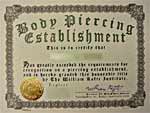
Sample “scam” certificates avaiable from Rafti, available without inspection. BME: You’ve met Rafti in person?CREEPER: Yeah, he came in here and looked around. But there wasn’t a piercer here at the time when he came in.
BME: There was no piercer working?
CREEPER: Nope.
BME: And I guess you can’t really vouch for Rafti’s skills or knowledge?
CREEPER: No.
BME: Has he asked you to instruct at his school?
CREEPER: He asked me something about it, but I said “no way”. I’m just not interested in the piercing thing any more. It’s gone way too wild for me! I pierced for ten years and apprenticed a lot of piercers. I don’t even do it any more. I just tattoo now.
Well, that’s the end of Rafti’s industry references.
Getting in touch with John Seaton of the Suffolk County Health Department was extremely difficult — I called for days, every few hours, and no one was able to ever find him (even Rafti had warned me that he was extremely busy). On my last day of research, when I was ready to write off Seaton as unreachable, he answered and I was able to ask him about Rafti’s credentials.
BME: Do you know William Rafti?
SEATON: I have a disc [from him]; he gave me a disc but I haven’t looked at it yet.
BME: He told me you would vouch for him as a piercing instructor…
SEATON: [laughing]
BME: …and that you’d been waiting 20 years for something like this to happen?
SEATON: [laughing hysterically] …You know, I hate to tell you: the guy came in, he showed a bill of goods, and I looked at him and it just sounded too fishy. You know when something appears to be too good to be true?
BME: He says you trained him and endorse him as qualified?
SEATON: [laughs] He may have been through my certification course and earned a certificate.
BME: What does that course involve?
SEATON: Knowledge of bloodborne pathogens. I teach a little course — a couple hours.
BME: So it’s not something that qualifies someone as a piercer; it just covers the basics of contamination control and so on?
SEATON: Yes — that’s all we can certify. As to skill as a piercer, the law doesn’t address that.
I’m sure no one is shocked at this point, but Rafti’s claims to be endorsed by the Suffolk County Board of Health as a piercer let alone an instructor are stretching the truth pretty thin. He simply took the afternoon bloodborne pathogens course offered by the county to anyone who wants to take it.
So what of Rafti’s lofty credentials? Perhaps he’d at least tell me where his degree was issued — after all, he was claiming not only to be a dude writing a book, but also a scientific researcher (he made the preposterous claim that soaking a piece of body jewelry in brine solution could detect how well it would fare in the body — anyone with even basic knowledge of implant standards as they apply to metallurgy and biology knows the notion is foolish).
BME: You claim to be an expert in this field — what is your actual experience that backs that up?
RAFTI: Thanks for implying that I’m an expert, you can also call me handsome if you want. I claim to be what I already said.
BME: I didn’t imply that you’re an expert, and you didn’t answer my question. Anyway, have you done other research-oriented writing that prepared you for this book?
RAFTI: I’ve written for other publications that would not like being associated with piercing or tattooing in any way, shape, or form so I will not mention them. I have a wall full of credentials — I have credentials for all kinds of things. My mentor, who’s name I am not going to mention, was an international attorney.
I studied anatomy — but don’t quiz me on it. I took a first aid course but my certification expired, and I was certified to run an air compressor.
BME: Ah, so you’re “qualified”, but it’s a secret. I see. In your book you say that you are a piercer and a tattoo artist. Who trained you and where have you worked?
RAFTI: I worked “underground”. The people who I’ve pierced came to me because they thought I would do a good job, distrusted the local studio, and gave me lots of understanding when things occasionally didn’t go as hoped.
I was strongly encouraged to go into piercing professionally — one of the studios that was going to hire me (no apprenticeship) instructed me to answer the phone by saying “Hello asshole, this is asshole speaking, what do you want?”
I will be doing a few tattoos within the next year on people who don’t care if it comes out right. [Editor’s note: That is not a typo — he actually said this!]
BME: Um… Ok. Sounds like you have high standards. So how many piercings have you actually done?
RAFTI: I’ve done about seventy to seventy-five actual piercings on living people and currently have no plans to do any more.
BME: So what makes you qualified to design and run a piercing school, let alone have the egomania to call it “the most advanced piercing course” available?
RAFTI: I’ve done at least seventy piercings, and I wrote my ebook.
BME: Whether you wrote that ebook or not is for the courts to decide. Anyway, have you ever even seen or attended any of the other courses available?
RAFTI: I have not received piercing certificates from any place other than myself, and that was a conscious decision based on my personal beliefs. I do have a proficiency test of my own creation but it is proprietary.
BME: How many students have taken your course?
RAFTI: None.
BME: Sounds successful… so basically, you can’t tell me anything about your imaginary school (or your credentials to run it), other than it’s the best, but the proof is top secret?
RAFTI: I will divulge the collagen aspect of my “most advanced piercing course”. What I am working with is so new that it doesn’t really have a name — I call it a “Matrix Resistance Simulator”. The trick to simulating mucosa surface lies in growing a kombuka hongo into a proprietary substrate matrix under a steady temperature. By using different frequencies of temperature change various densities can be achieved.
The advantage of my Matrix Resistance Simulator is that although it is very much like skin it is instantly self healing — unfortunately it can dry out to a scab-like crust long before it gets pierced to pieces, [so] it is best to keep it covered with saran wrap between uses. My program involves practicing the techniques in sets like a weightlifter does — can you do it ten times in a row without making a mistake? Can you perform a random series of piercings? I don’t want to see anyone piercing a person until they find their inner grace. It’s best that if a student can’t develop the eye-hand coordination that they fail.
BME: Well that’s about the goofiest training idea I’ve ever heard. It doesn’t make any sense at all — and there’s no such thing as “kombuka hongo”, so you may want to check with your alien advisors on that.
Do you even have any piercings?
RAFTI: That’s a rude question. I have one piercing, an 8ga frenum. I did pierce my ear once with a sewing needle, and with a thumb tack, and also with a staple. I also used an ear piercing gun.
Would you want a brain surgeon who’s never undergone surgery on his own brain to operate on you?
BME: You’re comparing apples and oranges — that analogy doesn’t make sense. A better question would be “would you get a massage from a masseuse that’s never had a massage” or “would you go to a restaurant where the chef has never tasted food?”
RAFTI: Thanks for contributing your own false analogy.
BME: Thanks for avoiding the question. Let’s move on. Ignoring the issues of your total incompetence in running it, if you have plans to run a legitimate piercing school, why do you sell “professional piercer, certified by the William Rafti Institute” certificates to anyone with $15?
RAFTI: I am also willing to make custom certificates for shops that offer their own training — the shop gets their name on their own certificate!
BME: But doesn’t that kind of invalidate the whole legitimacy of your potential school?
RAFTI: I believe that most of the piercers out there are qualified whether they have official certification or not. I believe piercing certificates are modern day talismans — they tend to bring on a desired calming effect that leads to better results. I believe that it is part of our tribal instinct to require talismans, as they enrich and empower us.
BME: Um… OK… You have to understand that it’s getting harder and harder not to laugh at your every response… So why have a school at all then if piercers are already mostly qualified, and all it takes to make them better is hanging up the magic “talisman” certificate you offer? Do the students even need you then?
RAFTI: When the students are ready the teacher will appear, or when the teacher is ready the students will appear — either way works for me.
BME: Now I understand, sensei. “If you build it, they will come.”
|
Now, I want to be very clear on one thing: I don’t think Rafti is an idiot. In fact, I think if you can ignore his overwhelming and eclipsing mental — and ethical — problems, he’s a lot sharper than many would give him credit for. He just happens to be crazy, and not in a good way. When I asked Rafti a question set that I ask of people who ask to become part of BME’s QOD staff he did far better than I expected he would — no better than the average piercer, and with some deranged rants thrown in, but better than I expected:
BME: “I have a 6 ga Prince Albert. I was interested in getting it changed to an apadravya, but both the piercers at the studio I go to say that isn’t possible — can you think of any reason why that would be?”
RAFTI: It’s possible that the studio is not comfortable using a 6 ga needle. Some studios prefer to go no thicker than 8 ga. You should give them a call or stop by the studio and ask them your question. Try to establish better communications with these piercers, you might learn a lot.
Another possibility is that your PA was pierced too close (shallow) to the tip of the penis, making proper placement of a apadravya impossible. A PA is normally placed about 5/8” to 3/4” back from head. Sometimes a studio may hesitate to tell you that you had your PA pierced too shallow out of fear that they might be insulting another piercer’s work. You might want to consider asking your piercer if it would be a better idea to do the apadravya behind the PA.
BME: Good answer, although I don’t think I’ve ever heard of a piercer trying to avoid saying something bad about another’s work.
Next question: “I have my nipples pierced right now (healed) and I wanted to get a second set. I wanted to get the second barbell nice and deep, so the old one pierces the full width of the nipple tip, and the new one pierces the full width of the areola. Would that work?”
RAFTI: I find the “pierces the full width of the nipple tip” part of the statement confuses me, but I think I understand the question. It could work, but only if your nipples are large enough. You don’t state whether both piercings are going to be aligned the same (horizontal or vertical). You are more likely to have enough room if the second piercing is done at opposing angles to your existing piercing, this is especially true if you prefer to wear barbells.
BME: Actually, this is a horrible idea — when you pierce a nipple this deep, you risk damaging and blocking milk ducts. In this commonly occuring problem, an infection can be trapped inside the breast (mastitis) and even lead to mastectomy. You really shouldn’t be recommending this depth of piercing to people.
Next question: “My piercer told me there’s aluminum in the jewelry he’s selling (along with titanium). I heard that aluminum exposure can lead to Alzheimer’s Disease… Should I use different jewelry then? Isn’t that a needless risk?”
RAFTI: I have personally tested a number of batches of titanium barbells, including anodized titanium and from my findings believe that titanium is at least equal to 316LVM for inertness.
BME: Well, the medical industry (and the piercing industry) has known for a long time that titanium is far superior to stainless steel for implantation use.
RAFTI: Here is an eye opener, there is a range of acceptable proportions for each alloy, and each batch of metal does not necessarily have the exact same properties as every other made by the “same” recipe. I could teach a seminar on this, it’s got interesting implications for all of us.
BME: Actually, metals made and certified for implant use are manufactured with very rigorous adherence to quality and there are not notable variations between batches.
Next question: “I heard recently that tools can’t be guaranteed sterilized if they’re in a pouch, but everyone says that I should be sure to watch them open the pouch in front of me so I know the tool is just for me… Who’s right?”
RAFTI: Neither, the best way to tell is to look at the sterilization indicator mark on the pouch. Tell the piercer you are a naturally “paranoid” person who doesn’t want to have nightmares weeks from now, and refer to your “phobia” of dirty needles. This will gain the sympathy of any piercer that I’d trust.
Then tell them to show you the mark on an unused pouch (the pouch will be labeled as to what kind of change to expect), and then [do] a visual examination of the sterilization mark on the sterile pouch that will be used in your procedure. If you do not see a distinct difference in color then you should be very concerned that sterilization is not what it should be.
BME: Well, that’s not true at all — those “sterilization marks” (they’re actually heat and pressure indicators) on the pouches are not reliable indicators of sterility.
Next question: “How often does the water in an autoclave need to be changed?”
RAFTI: It depends on the autoclave. If you are using a Prestige autoclave try not to leave water in it overnight. With many other kinds of self heating autoclaves it’s more important to keep the autoclave properly filled with water than to change it, as this prevents corrosion on the coils.
BME: Not changing the water in an autoclave is extremely dangerous! The endotoxins that build up in the water resevoir survive the sterilization cycle and can contaminate the tools and jewelry.
Next question: “I tend to get really woozy even watching a piercing. I want to get my rook pierced, but I don’t really want to pass out… What can I do to keep this from happening?”
RAFTI: Make sure to eat a meal an hour or so before getting pierced, eat a candy bar, or some sweet cookies (Oreos seem to be a blood bank favorite). Glucose tablets are also helpful for a lot of people, and are easily portable.
There is also a high glucose energy soda available that I saw in the supermarket — it cost $7.50 (US) for a one liter bottle. You might also want to look for this kind of thing in health and nutrition stores. A warning for vegetarians and vegans: glucose is blood sugar.
BME: Are you insane? While the common expression “blood sugar” does refer to glucose levels, glucose is not distilled from blood!
Glucose being made of blood because of the expression “blood sugar”… Classic!
Anyway, not that I think being able to answer these questions decently justifies his glaring theft and deception.
Talking to William Rafti turned out to be one of the biggest wastes of time for me in 2003. That said, while his ravings may seem like a combination of funny, pathetic, and ignorant, there’s actually a danger in lunatics like Rafti being around, especially when they persist in trying to create schools with false and stolen credentials. I realize that the average BME reader can see through him in a second, but not all clients — let alone potential piercers — are that well informed.
It’s often difficult for people to find an apprenticeship, and many people will jump at the opportunity to take part in a sham school like Rafti’s — after all, if you don’t know that it’s stolen, and you’re not familiar with computers, his book could give one the false impression that he is a leading author on the subject (rather than simply identifying him as a nut and a petty thief).
Rafti is a very sad case, because it’s pretty clear after speaking with him that he’s not particularly lucid, and really doesn’t have much of a grasp on reality — there really is a possibility that he genuinely believes that he wrote this book, and that his references check out, and that he has a lofty (albeit top-secret) set of credentials. I’ve been a little split on whether I should even publish this article, because it’s really making me feel like I’m beating up on a mentally handicapped kid (I feel even worse launching legal action against an invalid, but what choice might I have?). When it comes down to it, he is potentially endangering the public — at a minimum he is misleading them and stealing their money (and mine as well I suppose).
In any case, I hope this illustrates how important it is for consumers to be informed — scam artists and liars are rife in this industry (and in many others as well), and they’re not always easy to detect from afar.
Sincerely,

Shannon Larratt
BMEzine.com
Update
After I made it clear to Rafti that I wasn’t going to roll over on the copyright issues, and I informed his distributors and eliminated the majority of his ability to sell the book, he posted the following note on his website’s order page:
On of December 5, 2003 I became aware that some of the material I used in this book was improperly cited, this is very bad for me to have done. Over the last several years I have greatly improved my ability to organize things on the computer; this does not excuse any of the mistakes that I made along the way at all, even if I was unaware that I made them until now.
I sincerely believe that I’m doing very good work here, but I have a greater obligation to properly credit my sources than to add on top of something that obviously “stinks”, for this reason I am no longer making the Body Piercing Encyclopedia available for distribution in any format.
This project can not continue until I properly locate and credit sources that I have plagiarized. The problem in doing this obligatory task is that I have to compare all the information in my book, to all the information that is outside my book- logistically this is impossible for me to do.
If you support what Im trying to do, then I need each and everyone of you to send me any information that you can find of any material that I used without properly citing my source. I simply can not do this all by myself alone any longer, without your help the Body Piercing Encyclopedia Volume 1 is dead.
Please send constructive criticism only (please) to me at [email protected]
I wish to thank Mr. Shannon Larratt of BME for being the first to bring this to my attention, he does a lot of good work, Im sorry that I got some of his work confused with my own.
While I do appreciate that the stolen material is no longer being sold, it’s really “too little, too late”. The fact is that the result of my investigations into the text of the book strongly imply that it is nearly all stolen and from a myriad of sources — most of whom have no idea who Rafti even is (it’s not as if the webmasters of rhinoplasty4you are going to be buying his book). And I’m really not sure I buy his newfound “me so sorry” routine. I just can’t quite convince myself that one can “accidentally” commit fraud on this level and be totally unaware of doing it.
In cases of mass plagiarism it’s not enough to just say “let me know if you see anything stolen” — a request which makes it very clear that Rafti really has no idea where his text starts and the stolen text ends. I came into this review hoping that there would be something salvageable from this book, that my comments would result in improvements. However, I have come to the unavoidable conclusion that this book is rotten to its core and can not be saved.
Then of course there’s the matter of the money — Rafti has potentially made thousands of dollars by selling BME’s and other people’s work as his own. Personally I’m not in it for the money — I’ve always felt that this information should be as free as possible which is why BME/News, BME’s FAQs, glossary, risks, and encyclopedia projects have always been publicly accessible without charge and advertising-free. So while I may be entitled to it, I am not demanding at this moment that Rafti send me his profits. That said, if he wants to ethically purge himself I would encourage him to donate the proceeds to a suitable charity such as The Planetary Society, Antiwar.com, Adopt-a-minefield, or AIDS.org (and provide proof).
My only hope in all of this is that this “tough-love kick-in-the-ass” will help Rafti address these serious issues, both in his research methods and his deception about his potential skills. It’s clear from talking to him that Rafti is a driven individual who desperately wants to produce this project — and that’s a good thing. I do believe that Rafti has a better comprehension of the subject than most, and if he started over from scratch, being careful to properly document his sources, he might actually be able to produce something of real value.
That said, I don’t believe that Rafti is now or ever will be qualified to teach a piercing school and I think it’s a mistake for him to continue pursuing that path. I also think his needless confrontations with influential and integral individuals and organizations in the piercing world are constantly burning bridges and creating enemies where he should instead be fostering alliances and finding people to help him.
I think Wes Wood had the right idea when he said that he supported everyone who was working legitimately. I’m dismayed that Rafti is not. I’ll be surprised if he turns himself and this project around, but still, I hope he does.
CLASH: This is Omo Valley [The Publisher’s Ring]

CLASH: This is Omo Valley |
The urge to create, the urge to photograph, comes in part from the deep desire to live with more integrity, to live more in peace with the world, and possibly to help others to do the same.– Wynn Bullock
Recently BME had the opportunity to attend the opening of Liam Sharp‘s gallery show CLASH, being hosted at the Alliance-Francaise at 24 Spadina Road in Toronto (a two minute walk north from Spadina Station for TTC riders) — the show will continue there every day until January 10th.
The show featured photographs from his very recent trip to inner Ethiopia where he had the opportunity to photograph members of the Hamer tribe and others around the Omo valley that still practice ancient forms of body modification. We managed to pull Liam aside for a few minutes at the show and talk to him about his experiences.

BME: The thing that really surprised me is that you could still photograph activities like the big lip stretching — when I see it in books, it seems like it was disappearing forty years ago, but these are young people with these modifications. Was it hard to find them?
Liam: The reality is that there are very few areas still doing these things. It’s more and more difficult. I was just talking to someone that lived in Africa and he said that twenty, forty years ago you could just go outside the city and there’d be tribal peoples…
But even now, one thing you have to remember is that these cultures, these countries, are still extremely tribal. In fact, their governments are biassed in terms of tribes…
BME: As in for them, or against them?
Liam: Well both… The politicians represent certain tribes, so they’re slanted one way or another. That’s why there are coups and all these political problems — because the politicians really only protect the tribes they’re from. The tribes are identities or countries in and of themselves.
BME: With their own languages…?
Liam: They have their own languages a lot of the time, and also there are traditions you can see. There are three predominant tribes in this particular show — I visited about seven in all, and there are maybe fifteen in that one area. The Omo Valley region might be two hundred and fifty square kilometers. It’s not a huge area.
BME: How large are the individual tribes?
Liam: The Hamer tribe is about ten thousand people.
BME: So large enough that you never have to leave… you can stay inside the tribe, marry inside the tribe, and so on.
Liam: I think that’s how it’s done. I was photographing a guy from the Hamer tribe, the guy with the grip on the gun —
BME: I assume those are their guns? You didn’t ask them to pose with them?
Liam: No, no, of course not.
So I told him we’re going to this village in Oromati, and he said, “there’s no way I’m going there, if I step foot in that village, I’m dead!” since the Oromo are fighting the Hamer. The territories are extremely well defined, and they’re all kind of land-locked within those territories.
BME: They’re agricultural peoples?
Liam: Yes, very agricultural. But the terrain is extremely arid… I will never eat fried goat meat again — that’s all I was fed out there! Cows and goats, that’s it.
BME: How did you get there?
Liam: I was really kind of shit scared going on this trip… I sort of chickened out, but it’s important to do it this way and I always do it this way, which is to hire a local guide. I hired a truck with a guy — you can’t get there otherwise. The great thing about the guide is that he’s been in that area, and he knows the people, so he can smooth things over…
BME: Is that what he does? Just brings Westerners in?
Liam: That’s what he does… but in the whole time I was there I saw maybe five Westerners. So I’m not the only one, but there are very few… The others were there just to go I think, not to take photos other than just a few clips. That was one of the problems I think — their expectation that I would just take a few snapshots.
BME: How did they feel about professional photos being taken? Why did they think you were there?
Liam: That was always a big problem because my guide was always very suspicious of me. “Why are you taking these pictures? You’re going to make money from these pictures?”
And the fact is, as you can see, it’s not about the money. For me it was about going there and documenting these people, these tribal people, the way they live, and the way they are right now. But they didn’t like it. They wanted money — that’s what it was. I had to pay them three Birr, which is about forty-five cents Canadian per image [ed note: Liam took about 5,000 photos while on this trip]. Every time I clicked the camera, I had to pay. We had a suitcase full of money and my guide would just be paying it out.
BME: Isn’t that a bit dangerous?
Liam: It is… but it’s perfectly fine. You know why? Because paying money takes everything off the table. I’m going there and I’m giving them money and it’s an exchange. I’m taking their picture and they’re getting money. So it’s OK. That’s not a problem.
There was a situation when I was in the Omorati area, and photographed an older person, and the person collapsed
Are we going to get out of this situation, I was wondering? My guide said that if the old man had died, they’d have assumed the flash of the camera killed him — that this process, which they don’t understand, has killed this person. As soon as it moves to “you killed one of us” then very soon after it becomes “why don’t we kill you?” It’s very simple.
Luckily we ran over, and I supported him, and he was OK — but we got the hell out of there real quick!
They don’t particularly like the photographers. I really rode on the coattails of the relationship of my guide with the chiefs. As soon as that started to wear thin (which happened very quickly) I had to get out of there.
BME: Did you stay with the tribes, or just sort of roll into town, do your thing, and roll out?
Liam: We had a process — eventually it became repetitive and I was worried about that. What would happen is we would come into town, talk to the chief, and pay him off. As my guide was paying off the chief, I’d set up the backgrounds, set up the lights, and then he would tell everyone we were shooting and this is what the price was, and all that. Then I would just point to people in the crowd, and they’d come and I’d shoot them. One, two, three frames, and then the next person.
BME: They were OK with that?
Liam: They were OK, but it didn’t take long before they realized this was more than someone just taking pictures. They wanted to know what we were doing, what they were for — there was a big suspicion. I’m getting it here at the gallery too — questioning why I would want to portray Africa like this.
BME: One of the overwhelming comments I’ve heard walking around the show tonight is stuff like “oh, how disgusting they look” and “that one is even more mutilated than that one!” Does it seem strange to you that someone would come to your show and then say things like that?
Liam: No, not at all… That’s the biggest problem I’m had with going to places like this in the world. Westerners always look from this perspective, and that doesn’t respect these tribal peoples’ perspective. The fact is these people aren’t Canadian, they’re not living in this environment, and they don’t have the same culture. You can’t expect them to have our values and conduct themselves — or want to conduct themselves — like we do.
People are always asking me, “how could you take a picture of someone with a gun, how could you do this?”
The fact is that is how they are. That’s their culture, and that’s how they want to be! It’s just as ludicrous for them to wear clothes!
BME: You didn’t ask them to take their clothes off and paint their faces like that?
Liam: NO!!!! None of that is acting… That’s exactly —
THAT’S — HOW — THEY — WERE!
That’s it. That’s how they were.
\
|
Earlier we’d been joined by Roseanne Bailey, an African-Canadian woman, also a photographer who had lived and worked in Africa for some time. She expressed deep and very valid concerns that perhaps Liam was producing some kind of “savage erotica” akin to early exploitation films — and that by decontextualizing his subjects he might actually be doing them a disservice (basically a nice way of accusing him of being a racist and perpetuating the sins of colonialism because of his show).
|
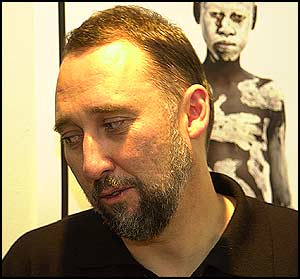
2003 APP EuroCon Report [The Publisher’s Ring]
 2003 APP EuroCon Report
Going to my first APP convention, their recent EuroCon in Amsterdam, I didn’t really know what to expect. It’s been many years since I had any real dealings with the APP — fights over my support for scalpel piercing, dermal punches, and so on led me to believe that they were an overly conservative bunch of elitist piercers that weren’t particularly concerned with my “progressive” vision of the future of piercing. A few friends that “defected”, coupled with the APP’s continuing difficulty in drumming up much support from this community had me writing them off as not just useless but dead.    And then I went to EuroCon. After attending almost every single seminar, and getting to talk to the board members and piercers, my mind was most definitely changed. I now see the APP as an essential and positive group that I hope all piercers will support and take part in — we need the APP! Having seen what they’re trying to do, I believe that the APP has the potential to be the backbone of the industry, serving to educate piercers, unite piercers, and present a strong front in dealing with the government and the mainstream public. The convention also illustrated the need for groups like the APP in keeping piercers informed and up to date on the overwhelming range of professional issues that can be very hard to keep up on in the absence of reputable trade journals and other organizations.
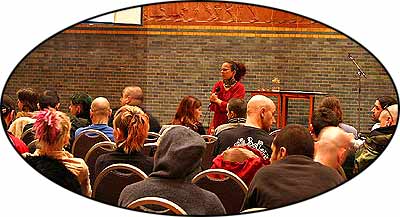 DAY ONE Rachel and I took an overnight flight, arriving the morning the convention started. We stopped at our hotel for a nap and got to the convention space at about noon where we were greeted by Bethra Szumski, the current APP president, as well as other familiar faces such as Alicia Cardenas of Twisted Sol in Denver, and Megg Mass of Infinite in Philadelphia. We’d missed the first class or two (bedside manner I think), but after lunch an anatomy course was scheduled. The anatomy class was being taught by Betsy Reynolds, an oral biologist who acts as somewhat of an advocate for the piercing community, counter-balancing some of the ludicrous statements made by anti-piercing dentists and so on. While the information she was presenting on healing was concise and relevant, I was a little surprised that it was being taught here at all — from my point of view it was disturbing that anyone wouldn’t know this anatomy in their sleep. The presentation was running slowly, in part because of constant interjections about piercing procedure. Eventually Paul King had to step in and ask that people save their procedure questions — this was an anatomy lecture and not intended as a technique debate. At the end of the first day I was still pretty convinced that it was going to be a waste of time. The anatomy course had been boring, basic, conservative, and Aimee (see sidebar) was doing her damndest to make the attendees look bad — or at least have a bad time. At the end of the day Rachel and I walked around town a little, stopped for a rather bland meal somewhere, went back to the hotel and went to bed.
DAY TWO Seminars in theory started at 9:30, so a little after 9 AM I arrived and was told the seminar — basic piercing technique — was pushed back until ten. Technical problems seemed to plague the event, and it wasn’t until 11:30 that things actually got started, with the technique seminar being bumped to the afternoon. I think the only good news, echoed by the people sitting around me, was that Aimee had decided to “skip class” that day, so at least we didn’t have to put up with her disruptions. Alicia then took over what was left of the morning with her stretching seminar. Given how basic the anatomy course had been, and because I’ve got more than a decade of stretching experience, I expected to be bored stiff — but I was very much mistaken! She started with diagrams showing exactly how stretching occurs on an anatomical level, detailing micro-tears and collagen replacement.
|
Also covered were stretching techniques, jewelry, and even lots of little tidbits for business owners like “stretching cards” (cards for your customers that encourage them to come back for slow and healthy stretching with incentives like 10% off on the next stretch if they wait). I do think Alicia has a little bit of an unfair bias against plastics, but she’s an engaging speaker that does a great job of covering basic material while throwing in enough trivia and advanced information to keep any level of audience enthralled.
After lunch, Bethra gave an in-depth and highly technical jewelry and metallurgy seminar. I was pretty tired at that point (still on Canadian time), and diagram after diagram of atomic structures was putting me to sleep. Since Bethra had prepared a hand-out with all the information, I took off for a nap. On my return she was just finishing up and Megg was about to start the basic techniques seminar, the technical problems having finally been solved.
 HANDOUT EXCERPT |
Megg’s also a great speaker and an experienced and progressive piercer who’s very good at presenting material that’s old hat to most people but with enough tips in it that I think even a piercing veteran would get a lot of out it, fine-tuning their techniques. Her seminar, prepared with Elayne Angel, contained numerous ideas that would improve any piercer’s work. Much of her seminar also focused on the subtle aspects of organizing a studio and its support staff to best facilitate and safe and pleasant piercing process.
 AT THE APP PARTY |
 AT THE APP PARTY |
|
 AT THE APP PARTY |
 COLD STEEL REPRESENTZ |
|
 BRUNO AND BRENNO |
 FRANCE REPRESENTZ |
|
 SO MANY RAFFLE TICKETS |
 AT THE APP PARTY |
DAY THREE
I showed up at 10 AM to again find that things had been pushed back even further — not so much for technical difficulties, but because people were simply late arriving. Maybe I’m a nerd, but if I had spent a few thousand dollars flying to a convention I’d go to the effort of showing up on time for the classes. I was surprised to hear that it’s not unusual at the Las Vegas convention for as many as half the people to not even bother showing up at all!
Meh.
The first seminar was one I’d wanted to take for a long time, the Bloodborne Pathogens course prepared by David Vidra and Health Educators, being taught by Alicia. This is one of those basic seminars that every piercer should know backwards and forwards, and like CPR certification, it’s the kind of thing they should be doing regularly to stay sharp. When it involves people’s lives — being able to provide a safe and aseptic foundation for your studio is the basis of this seminar — you don’t want to get sloppy!
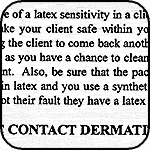  |
The presentation that followed was the one that really freaked me out and was probably the most eye-opening one of the event. Julien Ball of Prestige Medical, one of the leading autoclave manufacturers, gave an overview of modern sterilization technologies. It was fascinating to learn about the different procedures in Europe (for example, they use aggressive monitoring and charting of their clave’s performance, while spore tests are almost unheard of), but what really got to me was an overview of the difference between vacuum autoclaves and “normal” autoclaves.
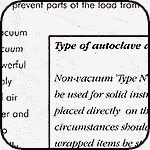   |
For those that don’t know, an autoclave sterilizes when the pressurized steam hits the surface of the items in the clave. If the steam doesn’t reach the items due to some blockage, sterilization doesn’t happen. Where it gets scary is that a simple pocket of air can, in some cases, provide this blockage. What that means is that a normal autoclave as is used by virtually 100% of North American studios can not guarantee sterilization of anything hollow (receiving tubes, tattoo tubes) or anything that has been placed in bags (basically all tools and jewelry) — there were definitely quite a few faces in that crowd turning white as Julien talked (see the handouts I’ve provided here for more information on this).
It was hard to get an answer out of Julien as to exactly what the risk level was — did these air pockets form every cycle, or one in ten thousand times? After all, Prestige Medical has a vested interest in the subject since there’s a higher profit margin in a $7000 vacuum clave than a $900 field-medic special! I was surprised to find out that about 70% of the piercers at the convention (the majority of the Europeans there) were using triple-pulse vacuum claves as well as single use water systems — some of the gear in the European studios was amazing. One German piercer even had an $8000 automated “tool dishwasher” in his shop!
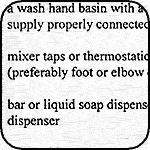 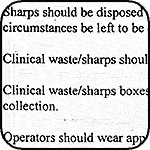  |
Al Prescott, organizer of the Derby conventions and developer of the Safe Working in the Tattoo and Piercing Industry vocational course, followed with an exhaustive seminar on risk management procedures which also touched on the extremely high standards that European (and specifically UK) studios are held to. I don’t think American or Canadian studios could match these without at least doubling prices — which might be a good thing since it could eliminate the low-end studios (although it could do the opposite since low-end studios tend to be more profitable and therefore more able to invest in new hardware).
The third day’s seminars ended with CPR certification which I skipped, but the day itself was to be capped with a party of everyone at the convention to give away some very generous prizes from the exhibitors — probably six thousand dollars worth of stuff was given away in the draws. Rachel won a belt buckle and some ring openers! I on the other hand won nothing…
 |
 |
 |
 |
 |
 |
DAY FOUR
The final day started with an aftercare presentation by Alicia, covering the pros and cons of a wide range of products in use by this industry. Unfortunately Aimee showed up about half way through it, shouting out a bunch of irrelevant questions which had already been discussed before she got there. I just don’t understand why someone would come all that way and act like such an ass… It was funny though — I think she must have clued in that she was pissing people off because when anyone would ask where she worked she was extremely evasive, just saying things like “a place on the east coast”.
Paul King’s informative and entertaining “amateur piercing anthropology and history” seminar followed. Paul is definitely a guy who I’d call a “piercing nerd” — someone who can go on and on about it and is interested in every little silly piece of trivia on the subject. Given that’s how I’d also describe myself, and given that it’s so hard for any one person to get a real picture of this community (so much of it is still oral history), it was wonderful to be able to assimilate his stories — many of which have been making their way into the new BME encyclopedia project (which will be officially unveiled on January 1st, 2004).
His stories about the rituals he watched during his travels in Penang were especially touching. We’ve all seen the gory photos of hundreds of thousands of people marching through the streets with giant cheek skewers — they seem so different from us — so enlightened. We are given the impression that they do these things naturally, and that everyone is in touch with God. That’s not entirely true though. Just like here in the West the occasional person will have to abort their suspension because they’re not ready to accept it, or it’s just not the right day, the same happens in Penang. I think the most moving photo I saw the whole time I was in Amsterdam was a young man sitting, emotionally exhausted, not able to take part in the ritual — and in his face I saw the same face I’ve seen in my backyard whenever someone asks to be pulled down from a suspension early because they can’t handle it.
It was at that moment, Paul said, that he realized that all of us in this world are the same.
Megg gave the final seminar, on legislation. I wasn’t sure how this was going to go over because some of the European piercers were already annoyed at the American bias on some of the subjects. However, the seminar didn’t talk specifics — its goal was to help teach people in down to earth terms how to deal with politicians. Given that Megg has helped Philadelphia come up with some of the best piercing legislation in the world, she’s more than qualified to teach this. Her anecdotes of her own successes in this area should be effective strategy for anyone around the world facing the same issues.
 HANDOUT EXCERPT |
The day finished on a bit of a sad note though, as Bethra thanked everyone for coming, and let them know that, for financial reasons, this would probably be the last time the APP would host a European convention. However, the day before the convention started they’d hosted a mini-event introducing all of the heads of the fledgling European professional piercing organizations — some had only two or three members, but I think they walked away empowered, and thanks to seminars like Megg’s legislation one, with new plans of attack as well.
I think everyone there was looking forward to the day when we’re able to have a world piercing convention, hosted by dozens of professional groups from all over the world.
 MEXICO REPRESENTZ |
 BRUNO, CHRISTIANE, AND TEN YEARS OF PAIN |
 ALEX AND FOXX |
 MEGG MASS AND PAUL KING |
|
THE CONVENTION FLOOR
A small but nice cross-section of jewelry suppliers from around the world had booths at the event. Most of it was the same stuff that you’d see at every single tattoo convention — in all honesty I think they could have done without the floor. That said, I’d like to mention Quetzalli, an organic manufacturer from Mexico that had truly gorgeous examples of ammonite-inlaid ear jewelry as well as plugs filled with intricate and beautiful beadwork.
 |
 |
 |
 |
 |
 |
CONCLUSION
I met a lot of really wonderful people — a lot of old friends, online friends, and many new ones as well. Bruno and Brenno from Italy were wonderful — talented piercers and body artists full of enthusiasm in their fledging association. Christiane from Norway showed me Håvve’s new book, Ten Years of Pain, about the history of the Pain Solution performance art group (the book is wonderful and I hope to have it in BMEshop soon). Russ Foxx from Canada was great fun to see, as was Carlos Escobar of Spain. It was also nice meeting piercers like Alex from the UK who I knew from the good things their many clients I deal with all the time said about them.
I know I’m forgetting people! I apologize!
I also met with Andrea (Lacrima Rubra) from Germany who showed me video of years of her performances and introduced me to some new friends and other friends who — like so many of my acquaintances — I know only by their genital mods! I also got to see my old friend Patrick Bartholomew again which is always nice, and Kor (Ego Kornus) really impressed me as well. It was very interesting to talk to a performer who comes from an art (modern ballet) and ritual background more so than a body modification background. And the forty or so beers we drank that afternoon between us polished off that day very nicely!
I could name people endlessly and still forget some who made the event worthwhile for me, so I’ll get back to EuroCon itself. I had three main problems with the APP convention that I think to be fair I should mention. First, I thought parts of it were disorganized and unprofessional, resulting in things like handouts not being ready on time and projection systems not working — given the expense that had been gone to in hosting, and the fact that the attendees had spent a lot of money to come I thought this was unfortunate. That said, as someone who’s hosted events, I know this is pretty normal.
Second, I thought better fact checking could have been done. While the presentations given by specialists were very strong, some of the more general reports were riddled with historical errors, typos, and substitutions (naming the wrong soap as vegan and so on). They were just little things, but I felt that it’s that final touch that really makes a presentation perfect.
Finally, an exceptionally poor job was done in marketing and promoting the convention. Most of the European piercers I talked to had absolutely no idea there was an APP event in Amsterdam, and those that did assumed it was for Americans only and not oriented to Europeans. A lot of the value of the convention came from dialog with the attendees, not just the lecture sessions, so this mistake was their most serious.
Let me be very clear though — those complaints are listed in order to be thorough and honest. I do not believe that they tainted the conference to the point where it wasn’t worthwhile. While the majority of the information being presented was old hat to me, there were still volumes of knowledge being shoveled that was new and that I needed to hear — and that every piercer needs to hear.
The next APP convention — a much larger one that draws over a thousand piercers (some of the best in the world) — is at the start of May, 2004 in Las Vegas. Now, it happens to coincide with Shawn Porter’s wedding, so I’m going to have to miss a day, but assuming that America doesn’t stop me at the border, I’ll be there, eager to keep learning. I hope you’ll be there too.
See you in Vegas,

Shannon Larratt
BMEzine.com
PS. Thank you to the APP for inviting me to come and being generous enough to extend my press passes into the seminars. Thank you as well to Bethra, Megg, Paul, and the other APP members for making me feel welcome. Finally, thank you to them as well as Julien, Al, Betsy, and the other speakers for sharing their knowledge.
Does God Hate Your Tattoos? [The Publisher’s Ring]

Does God Hate Your Tattoos? |
“For no man ever yet hated his own flesh; but nourisheth and cherisheth it, even as the Lord the church.”
– Ephesians 5:29
|
Way back in 1995, about a year after starting BME, I received the following semi-literate email:
“I think you are doing is self mutilation and I for one am very disgusted. But there is hope for you! Read the BIBLE!”
It may come as a surprise that I actually have read the Bible, and it no more says “don’t get tattoos” than it says any number of other cultural concepts — not theological concepts — such as “spare the rod, spoil the child.” In fact, the Judeo-Christian family of faiths is full of tattooed and pierced characters, and parts of the Bible are very clear that extreme modifications — self-amputations even — are what God wants for some people. Under Christian theology, body modifications are like words — they’re tools. They can be used to bring glory to God and help live a good life, or they can do the opposite.

There are many parts of the Bible that mention piercing in passing since it was relatively normal in Biblical times, but the only passage that seems to even vaguely ban body modification — tattoos* in this case — is of course Leviticus 19:28, which reads,
“Ye shall not make any cuttings in your flesh for the dead, nor print any marks upon you: I am the LORD.”
|
* I should note that the original Hebrew text reads “k’thoveth qa’aqa”, or “writing that is stuck in”, usually used to refer to a form of modification closest to ink rubbing — a pagan funerary rite at the time, very different from modern tattooing. |
Leviticus is a book of laws telling the Jews of the time how to lead their lives. As such, the laws break down into three general types — first, laws regarding morality (bans on prostitution, bestiality, and so on); second, laws regarding health (advice on subjects such as food preparation — kosher laws); and third, laws to differentiate the Jews from the pagans (bans on certain rituals, haircuts, and so on). In the New Testament Jesus does away with these laws. That doesn’t mean that bestiality is suddenly OK, but it does give a modern Christian much more personal freedom in terms of things like the way they trim their beard and the way they choose to decorate their bodies, because they are now judged by their faith, rather than adherence to a set of hard and specific rules.
“Therefore we conclude that a man is justified by faith without the deeds of the law.”
– Romans 3:28“Let no man therefore judge you in meat, or in drink, or in respect of an holyday, or of the new moon, or of the sabbath days.”
– Colossians 2:16
This is explained perhaps more clearly in Galatians 3:23-24, which tells how Jesus replaced the old covenant with a new one:
“But before faith came, we were kept under the law, shut up unto the faith which should afterwards be revealed. Wherefore the law was our schoolmaster to bring us unto Christ, that we might be justified by faith. But after that faith is come, we are no longer under a schoolmaster.”
As well as the mention of tattooing or cutting in Leviticus, body piercing is also mentioned throughout the Bible. When the Israelites fought the Ishmaelites, Gideon told his warriors that they could take the golden earrings of the enemies they slew (Judges 8:24), and numerous passages mention the piercings of the Israelites as well (Exodus 32:3, Ezekiel 16:12, Isaiah 3:21, and so on). Other sections, in Deuteronomy 15 and Exodus 21 describe body piercing on servants (as a normal part of society), and nose piercing is described as beautifying and normal when Behuel and Nahor’s daughter is married in Genesis 24.
Sometimes Christians object to body modification on the basis of it defiling God’s creation — after all, 1 Corinthians 6:19-20 is fairly clear that the body is the temple,
“What? Know ye not that your body is the temple of the Holy Ghost which is in you, which ye have of God, and ye are not your own? For ye are bought with a price: therefore glorify God in your body, and in your spirit, which are God’s.”
Earlier, in 1 Corinthians 3:17, a dire warning is issued:
“If any man defile the temple of God, him shall God destroy; for the temple of God is holy, which temple ye are.”
The question is, what does “defile” mean?
I’ll spare telling you that the Catholic Church has already publicly proclaimed tattoos as acceptable, and that Crusaders were commonly covered in Christian tattoos in order to proclaim their faith and ensure a proper burial — A good way to understand what’s appropriate for a temple is to look at the range of Christian churches that history has produced. Until about the 10th century A.D., Christian architecture was largely reminiscent of earlier Roman buildings. In the Middle Ages huge Cathedrals dominated, covered in spires, sculptures, buttresses — anyone who’s been in these structures knows how overwhelmingly powerful they are psychologically.
The Gothic period produced churches with complex and intricate decoration and gorgeous glasswork. Centuries later in the Baroque era churches were less physically imposing, but were encrusted with wealth — golden opulence was used to manifest God. Other periods and areas have seen simple churches, small humble buildings relatively unadorned with the people themselves bringing the glory, and in modern times we’ve seen churches constructed in every conceivable style. We’ve even seen very successful temples built using nothing but television transmissions and a studio.
Marshall Mcluhan may be oft-quoted saying that the medium is the message, but in this sense, I think God might correct him and say, “No, Marshall, it doesn’t matter what the medium is — it’s the message that counts.”

I hope it’s clear that if we’re to speak in objective terms, that there’s no specific ban on body modification in the Bible, and that its value as something good in one’s a life versus its involvement in sin is very much determined by the way it’s being used — to put it another way, telling someone that their Christian tattoo is wrong would be no better than telling someone that praising God is wrong because someone else shouted blasphemies. Speech — and tattoos — are just a part of life. They can be right, or they can be wrong.
So a Christian certainly can’t go out and get a tattoo or other body modification if it leads to sin, or stands for sin, but modification — mutilation even — is acceptable if it helps the person lead a righteous life. Sex might be another good example. The Bible is full of things that could make a person believe that sex is a bad thing — prostitution, lusting after others’ wives, and forms of masturbation are all mortal sins. However, reading other parts of the Bible it’s clear that God intended sex to be something wonderful — but He wanted it to be used in the right context (a loving marriage under God).
“Thy two breasts are like two young roes that are twins, which feed among the lilies.
Until the day break, and the shadows flee away, I will get me to the mountain of myrrh, and to the hill of frankincense.
How fair is thy love, my sister, my spouse! how much better is thy love than wine! and the smell of thine ointments than all spices!
Thy lips, O my spouse, drop as the honeycomb: honey and milk are under thy tongue; and the smell of thy garments is like the smell of Lebanon.
A garden inclosed is my sister, my spouse; a spring shut up, a fountain sealed.
A fountain of gardens, a well of living waters, and streams from Lebanon.
Awake, O north wind; and come, thou south; blow upon my garden, that the spices thereof may flow out. Let my beloved come into his garden, and eat his pleasant fruits.
Open to me, my sister, my love, my dove, my undefiled: for my head is filled with dew, and my locks with the drops of the night.”– The Song of Solomon
It’s all about context. That which might be a sin when used against God is a beautiful thing when used for Him — it’s why a Christian couple can have a fulfilling and guilt-free sex life that involves bondage, anal sex, oral sex, Cleveland steamers, or whatever else makes them happy — as long as it’s loving and sanctifies the marriage bed (so no Cleveland steamers with the neighbors when the wife’s out of town!).
To give a more extreme example, eunuchs (castrated or even penectomized men) were common throughout various cultures in Biblical times, and hence came to be included in the Bible and were even embraced by several sects. The Byzantine Church had numerous eunuchs in ruling positions, and the Christian Coptic Church embraced castration as a holy path. While relatively common between 300 A.D. and 1,100 A.D., it continued in eastern Europe until surprisingly recently. Matthew 18:8-9 warns,
“Wherefore if thy hand or thy foot offend thee, cut them off, and cast them from thee: it is better for thee to enter into life halt or maimed, rather than having two hands or two feet to be cast into everlasting fire. And if thine eye offend thee, pluck it out, and cast it from thee: it is better for thee to enter into life with one eye, rather than having two eyes to be cast into hell fire.”
Matthew 19 continues, warning against adultry and other sins of the flesh, and in verse 12 says,
“There be eunuchs, which have made themselves eunuchs for the kingdom of heaven’s sake. He that is able to receive it, let him receive it.”
Even extreme body modification is permissable — if it’s done to serve God or to protect the individual from falling prey to sin or to God’s enemies. Of course, modern Christians on the whole believe this passage is “metaphorical”… but there’s certainly nothing that says that clearly, and if it’s metaphorical, how can one decide what else is as well? Many early Christian scholars such as Origen, considered one of the fathers of the faith, castrated themselves. A small number of patristic writers such as Tertullian actually referred to Jesus as a eunuch.
So what we see in the Bible is that Christianity has at best one highly vague ban on a specialized form of cutting, and then goes on to describe body piercing at length as normal, and even goes so far as to encourage extreme body modification when done for the sake of God. The New Testament contains one clear and overwhelming message: Love. Under Christian theology the whole point of God’s appearance on Earth as Jesus was to get rid of blind arbitrary rules, and replace them with a more fluid code of goodness.
“This is my commandment, that you love one another, just as I have loved you. Greater love has no one than this, that one lay down his life for his friends. You are my friends, if you do what I command you.”
– John 15: 12-14
I won’t get into it in this article in any depth, but the Bible also draws similar conclusions about ritual. In 1 Kings 18 and Mark 5 we hear descriptions of pagan sorcerers and priests performing rituals involving cuttings and bloodletting, but at the same time, Christian penitents and monks have been performing self-flagellation and even crucifixion in the name of their faith (Matthew 16:24) since the beginning — not a single early Christian church didn’t embrace these rituals and they are still popular in many areas such as Brasil and the Philippines. Again, it’s all a matter of what you’re using the tool to achieve.

Some Christians will warn others against involving themselves in tattooing or piercing because they perceive it as being sordid, using scripture such as Romans 12:17 to justify it,
“Recompense to no man evil for evil. Provide things honest in the sight of all men.”
However, it should be clear from the “double standards” in the Bible that God doesn’t believe that one should censor oneself because someone else has used a tool for evil. You can wield a sword in God’s army, or you can wield in as knight in Satan’s service — your final resting place is not determined by the sword, but by the army you choose to serve in. When Paul says in Philippians 4:8,
“Finally, brethren, whatsoever things are true, whatsoever things are honest, whatsoever things are just, whatsoever things are pure, whatsoever things are lovely, whatsoever things are of good report; if there be any virtue, and if there be any praise, think on these things.”
he isn’t saying to think of things that appear to be true, or appear to be honest, or appear to be just, pure, or lovely — he’s giving clear message in clear terms: be a good person and put Jesus above all else.
If you want to be a good person with tattoos, God will still love you. The Christian who tells you otherwise isn’t hearing the message for some reason and may need your help far more than you need theirs.

Shannon Larratt
BMEzine.com
PS. I am not a Christian, but if you’d like to meet other Christians interested in body modification, you can click here to meet them in the new BME Personals (or place your own ad), and there are of course many more on IAM — a few are linked in the interview above.
What’s in a Name? [The Publisher’s Ring]

What’s in a Name? |
'Tis but thy name that is my enemy;
Thou art thyself, though not a Montague.
What's Montague? It is nor hand, nor foot,Nor arm, nor face, nor any other part
Belonging to a man. O, be some other name!– Romeo and Juliet, Act II, Scene II
William Shakespeare
Much of who we are is defined by our community and our family. Our skills, interests, and our names are all chosen primarily by others while we were children and infants — modern body modification is a part of a larger set of actions that represent a significant step in human cultural evolution — the end of homogeneity.
The Internet has played a fascinating role in this shift through the seemingly innocuous requirement of asking people to choose usernames for their email, websites, and IM clients — what is this but an adult choosing to name themselves? Thus it is put into common consciousness the idea that one’s identity is self-defined, rather than externally assigned. There’s nothing stopping people from using their real name online, but how many people do you know that do that?
Until recently, online identities tended to be secondary — almost like secret identities — but as the line between the online world and the offline world blurs, the dominant identity takes control, and often that’s the online one. For those of you who’ve attended IAM BBQs and other offline events of online communities, you know that you are more likely to know people by their chosen name than their given name. As a result, name tags usually list the IAM name, and it’s very normal for people to refer to each other by those names in conversation — and often not even know the given name of their friend!
People with body modifications are already very used to a self-defined identity — an adult identity that’s different than the child identity — so it should come as no surprise that an increasing number of IAM members are legally changing their “real” names to match the identity they’ve created for themselves. Now, before you cringe at how weird this is, ask yourself: Are your friends the ones you chose, or were they assigned? Do you watch the movies you choose, or are they assigned? Do you wear the clothes you choose, or are they assigned?
Why should a name be any different?

Meet the Reverend Grenade Bee Of Death, who you may also know as iam:Grenade. When he married he took on his wife’s name with his own, and of course after their divorce it only reminded him of things he’d rather forget. He worked a solitary job, and over time most of his friends were people he met online, where while playing the game Planetarion he was known as The Holy Handgrenade of Antioch. Grenade came to be his regular online name, and when he started meeting online friends in person, no one could bring themselves to call him “Martin” — so the nickname Gren stuck.
The name Martin became less and less relevant as almost everyone called him “Gren”. After an epiphany as to the nature of people and friendship, and after time spent with good online friends he legally changed his name to Grenade Bee Of Death. After posting this to his IAM page, and explaining how easy it was, he helped a few others do the same.
I asked him whether he felt different with his new name and what he described was very similar to the amputee fetishists who when asked if they feel different without their legs reply, “no, now I feel normal!”
I find that there is very little difference, to be honest. Given that very few people need to use my surname in addressing me, and that people have been calling me Gren for a long time, I feel little change.I had to give my name to a policeman the other day, and I got the distinct impression he thought I was taking the piss, but he was very reasonable about it, just asking me for spelling.
On an emotional level it is kind of liberating, and in the same way that I embraced piercings and tattoos... it is something that I have chosen for myself. I think it's another thing that makes me feel more in control of my own life.
Obviously there are some elements of regret, in that I no longer carry my family name. I guess that if I change my mind later, then "change of name" is a fully reversible "mod"!
Now meet Swirly Wanx Sinatra, the first person to contact Gren about doing the same, formerly swirlywanx on IAM, now going by his full and legal name, iam:swirly wanx sinatra.

About two years ago “Daz” started realizing that blending in just wasn’t for him. While looking through large amounts of tattoo flash with an older brother he saw that it was mostly just commercial scribbles and commented, “that’s awful… just a load of swirly wank!”
The comment stuck, and when he joined IAM he did so as swirlywanx — of course at BBQs people had no idea he was actually Daz, and simply called him “Swirly”. At the same time his non-IAM friends started doing the same, and in jest started adding surnames and completing the identity. Soon he realized that he’d “grown into” Swirly, and after choosing “Sinatra” as a classy surname (“Wanx”, sounding too much like a down-on-his-luck pornstar, was demoted to a middle name) he legally became Swirly Wanx Sinatra.
Other than the occasional outburst from fools thinking he’s degrading Frank Sinatra, after a bit of checking that they’re not being messed with, people tend to respond with something along the lines of “that’s fucking cool… stupid as shit, but cool!”
Now meet RooRaaah Mew Crumbs.

For his whole life, Andrew Paul Johnson had been called Roo (on account of And-rew of course) — you know him on IAM first as AndyRoo, then RooRaaah, and now as iam:MisterCrumbs. He never liked his full name, and it didn’t feel right — “it just doesn’t fit with how I see myself.”
Starting with Roo, a friend a few years ago added “Raaah” and he liked it (“simple as that!”). “Mew” comes from his passion for cats, and his tendency to actually say “mew” a lot in conversation (“you have to experience it to appreciate the full greatness of how it sounds”). “Crumbs” as well comes from a quirk of his character and interests —
I think it stemmed from Danger Mouse... I'm not sure if you have seen it but Penfold used to say "Crikey crumbs sir!" when they were in a spot of bother, and it stuck with me.
Now that the change is complete, RooRaaah refuses to answer to “Andy” any more, and has spent the last while trundling around Liverpool changing his details. His workplace was incredulous and tried to refuse to accept the name change, but ultimately they didn’t have a choice — it is his legal name. At first there was a lot of explaining, but now he just leaves them stumped with a “why not”.
It's very liberating changing something that has been with you since birth, but that wasn't of your deciding. To other people it's only a name, but to me it's my identity — or at least a small part of it which the outside world uses to address me.Andrew Paul Johnson or RooRaaah Mew Crumbs — not a hard choice really is it?
I just feel more relaxed with this name. When I think of Andrew Paul Johnson, I don't think of me. Now, when I hear my name, I do think of me.
HooorahRooRaaaah!
In a recent poll of about 1,500 BME readers, only about forty percent said they’d never considered changing their name — this is a very common drive. Well over a hundred people told me they actually went by a chosen name, and forty-five of those had legally committed to the change.
In talking to people who’d chosen their own names and rejected their given names one commonality appeared — the idea that the new name “felt right” — that it actually represented who they were, rather than acting as simply an ID tag of sorts. Body modification is of course the same phenomena, a remaking of the self into what “feels right”, and it’s for that reason that the online body modification community is one of the groups pioneering what may soon come to be a tsunami of name changes reflecting online identities.
What effect this will have in the long term is of course still to be determined — is the world a better place when we don’t feel identity-bound to the past? Can you build a successful tribe out of a multitude of individuals, or do you need people to voluntarily accept some degree of slavery? I hope these people’s stories help you think about your name and what it means to you, whether you have any interest in self-defining or not.
Good luck figuring out how you’d like the world to know you,

Shannon Larratt
BMEzine.com









